Dear Friends and Family - since wifi is expensive for us in Canada we can only upload the blog with all the pictures when we get free wifi at marinas. So we are uploading the blog in bulk when we can. This one covers 8 days. The Our Log and Track page has also been updated. Thanks for all the comments - we really enjoy reading them and knowing that you're following our trip. July 6th, Friday - Day 63: Today was dedicated to getting caught up on reprovisioning our pantry and a few other boat chores before continuing our return trip down the Rideau, so there’s not much to report for this day.
July 7th, Saturday - Day 64: We departed our slip in Smith’s Falls at 8am and headed for the waiting area for the first lock which opened at 8:30. Our hope was to make it back to Kingston in less than 2 days, in order for us to stay on our rough schedule, and give us some time to go beyond Kingston and start our tour of the 1000 islands area in the St. Lawrence River. So, in order to make our objective, we had to push ourselves to put as many miles and locks behind us. Armed with brand-new, Belinda-sized docklines, we starting knocking off the locks with much more ease.
By the late afternoon, we targeted Morton Bay for our overnight stopover location, where we had anchored 7 days earlier. On the trip up the canal, we had anchored there and discovered massive amounts of vegetation on our anchor and chain when we pulled our anchor up. Assuming that this messy experience was just the result of picking the wrong spot in the bay, we chose another spot, dropped our anchor, and settled in for the night under dark, star-filled skies and a wind-less night.
July 8th, Sunday - Day 65: We awoke early, anxious to get underway in order to make it beyond Kingston and into the 1000 islands by the end of the day. When Jim stepped on the windlass (the winch that pulls up the anchor) switch, the chain started being captured by the windlass gypsy, and as it started coming up from the depths of the bay, revealed an absolutely huge ball of vegetation, including a 10 foot long tree branch (about 5 inches in diameter) completely captured and tied up by the anchor chain. After about a full hour of tugging and pulling and cutting, the tree branch was still very much secured to the anchor chain with little hope of being freed without either Jim or someone else working on it from below. Fortunately, we shared the bay with a fishing boat with three women fishing, who saw our dilemma and came over to see what, if anything, they could do to free us from our extra anchor that we had picked up overnight. By lowering the branch back into the water, it became somewhat buoyant and the chain was able to be unwrapped from the tree limb. Once underway, we proceeded at the fastest speed possible, given the narrow and shallow channels ahead, realizing that our destination beyond Kingston was in jeopardy with our late start. The last lock of the day was Kingston Mills, just north of Kingston, which we arrived at by 2pm, but since it is a 4 step lock, if we happened to get to the lock when it was closed, and even worse, if it had just started lowering boats down the
steps, we would be forced to wait an hour or longer, for all of the chambers to be filled (on the upbound side) or emptied (on the way down). We fortunately got there right before the gates closed and were able to squeeze in with several other boats for the ride down the steps. After exiting the Kingston Mills locks, we had less than an hour to make it to Kingston and through the lift bridge that opened at 3pm which we need to do because, following that opening, it didn’t open again until 6pm. We managed to make it to the bridge 10 minutes ahead of the 3pm opening and proceeded out of the Kingston harbor into Lake Ontario toward the 1000 islands without a clue as to where we would spend the night that night. We had several choices, since many of the islands are in the national park system and our annual pass entitled us to free overnight dockage. But the catch was that there had to be space for a boat of Rickshaw’s size and there had to enough depth up to the docks for us, which limited our choices significantly. After passing several islands that were either already full or were too small, we decided to push ahead to the closest town of any size on the Canadian side of the river, which was Ganonoque, and stay at the local marina there. Motoring up Bateau Channel, which hugs the Canadian shore, we were 5 miles from Ganonoque, when Jim noticed another DeFever parked at a dock on Howe Island, which is one of the larger islands in the 1000 islands archipelago. He picked up the binoculars to try to see the name (in case we might happen to know them), and saw that it was a 41 DeFever but didn’t recognize the boat, Cop’er Tub. The dock was kind of interesting because running 40 feet off of the dock parallel to the shore was a series of inflatable pool floats depicting various animals like turtles, dinosaurs, etc., tied together and forming some sort of silly-looking channel or shoal marking. Up on the hillside, in front of a very impressive home, was a sign that said “Keeler’s Landing”. We then noticed that there were 4 people on the dock waving their arms and yelling at us to come closer. By that time we had almost past by the menagerie of pool animals, so we made a u-turn and went back to see what all of the commotion was about. The people on the dock appeared to be waving us in, encouraging us to come and park at their dock. When we arrived at the dock to see what they wanted, we discovered that the owners of the house on the shore, who owned the dock, were former DeFever 44 owners (Frank & Ruth Keeler) who had sold their beloved DeFever that they had owned for almost 20 years, loved to talk to DeFever owners and had a “open dock” policy of letting other DeFever owners park at their dock for free. The owners of the DeFever 41 (Jim & Mary Cole) were dear friends of theirs from Syracuse who were visiting them. We visited until after 11 that night, hearing all of Frank’s and Ruth’s cruising stories of their life on their DeFever around the loop in the 90’s and for many years in the Bahamas. They seemed so excited to meet other DeFever owners and went way out of their way to make us feel welcome, including giving us detailed suggestions about where to go in the 1000 islands, and offering to loan us charts that we were missing. It was incredible.
July 9th, Monday - Day 66: Because of our experience with checking into Canada in Kingston, we definitely wanted to avoid taking Rickshaw back to the US (to see that part of the 1000 islands) and then coming back into Canada. One of the must-see destinations in the 1000 islands is Boldt Castle, on Heart Island, on the US side. Boldt Castle was built in the early 20th century by George Boldt, the roprietor of the Waldorf-Astoria Hotel in New York, as a valentine’s present to his wife. His desire was to create a replica of a Bavarian castle on the St. Lawrence for his wife, but, tragically, she died before it was completed, and he abandoned the project, and left the unfinished castle to the harsh elements. Several years ago, it was purchased by the Thousand Islands Bridge Authority, who has been slowly bringing it back to where it was before work stopped, and beyond to full completion. Typical of the Keeler’s generosity, Frank offered us his pickup truck to use to drive into Ganonoque to catch the tour boat that would take us on a 3 hour boat cruise throughout the 1000 islands, plus a 2 hour stopover at Boldt Castle. That night, back at Keeler’s Landing, Frank and Ruth invited us up to their home for a wonderful dinner and more tales of the cruising life.
July 10th, Tuesday - Day 67: After absorbing the local knowledge of the 1000 islands from the Keeler’s, we pulled away from their dock and continued down the St. Lawrence, meandering among the many, many islands, past small 800 sf cottages that consumed small postage stamp sized islands, and massive homes with boathouses bigger than most homes and waterfalls, fountains and manicured lawns on larger islands. After cruising by several possible overnight stopover sites, we settled on a small island, Georgina Island, just south of Rockport, Ontario, which was about 18 miles further down the river from the Keelers. Georgina Island is one of the many islands owned by Parks Canada, and is essentially a wild, no frills, natural park with several small inlets and coves available for boaters and campers to stay at overnight – for free, with the annual pass. After docking, we jumped off of Rickshaw, and hiked the perimeter of the island, then returned back to the boat, and dropped Ricky-Dink (our dinghy) into the water and went exploring up and down both sides of the St. Lawrence River for several miles, pulling as close as we dared to the impressive home and sheer rock cliffs that line the river. Upon our return to Rickshaw, we went for a short swim in the crystal clear waters of the Georgina lagoon, and feasted on hamburgers on the aftdeck.
July 11th, Wednesday - Day 68: We awoke early (in Canada, the days are really long with the sun coming up at 5 and staying up until 9pm). One of the tradeoffs of sleeping on our boat with the windows open to feel the cool night air is that our cabin is very bright, very early in the morning. We noticed that another looper boat had arrived in our lagoon that morning, a small, sleek trawler named Irish Wake, with a couple from New Brunswick, Canada on board. We visited with them for a short while then said goodbye and untied our dock lines and headed back to the Keeler’s because Belinda had offered to fix dinner for Frank, Ruth, Jim & Mary as partial repayment of their warm generosity, featuring her specialty dish, Shrimp Creole, with a special dessert treat of Bananas Foster. Upon returning to Keeler’s Landing, Belinda eagerly received three more Belinda-sized dock lines that Jim (from Cop’er Tub) had very generously picked up for us at West Marine earlier that day. The six of us feasted on our aft-deck and swapped more tales, before calling it a night when the mosquitoes discovered us and tried to make us their dinner for the night.
July 12th, Thursday - Day 69: We said our goodbyes to our new-found friends, Frank & Ruth Keeler and Jim & Mary Cole, at Keeler’s Landing, and headed southwest down the St. Lawrence toward the start of the Trent-Severn Waterway, 60 miles away. After passing by Kingston, we meandered through the narrow channel in the Bay of Quinte, which is on the northern shore of Lake Ontario, and pushed toward Trenton, Ontario, which prides itself as being the “Gateway to the Trent-Severn Waterway”. Instead of continuing all of the way to Trenton, where we would have to pay for a marina, we opted to stop about 5pm at a nice bay 12 miles short of Trenton, where we dropped our anchor in a small cove with a couple of other boats, had a short swim, then enjoyed dinner on the aft-deck. About 10pm, we went back outside to look at the stars, and noticed a 20 ft. ski boat 50 yards away from us sitting in total darkness. We had seen this boat earlier in the evening with about 6 people on it, including a small child. We could tell by the voices earlier, and the conversation that carried across the soundless anchorage, that there was a bit of drinking, and every now and then, thought we caught a whiff of pot in the air, so we knew that they had been having a good time. Now we could hear some discussion about the boat having a dead battery, and since the boat was obviously not one that you would normally sleep aboard, especially with a small child, we called out across the water to ask if they needed any help. But were told “no thanks”. About that time, we saw a couple of flashlights bouncing around in the woods heading down the shore line in the direction of the boat. We finally concluded that 2 of the people on the boat had swam to shore a few hours earlier (about 60 yards), gone somewhere, somehow, and got a battery, and were now swimming across the black lagoon towing some sort of float with the battery. We flooded the situation with our spotlight, watching the couple and their floating battery finally reach the ski-boat. Ten minutes later, the ski boat started and the lights came on. The drunk Canucks were certainly resourceful in resolving their situation.
July 13, Friday - Day 70: We awoke at the absolutely still anchorage and saw that the ski boat had gone back home, pulled up our anchor, and headed the remaining 12 miles to Trenton. After tying up at the local marina, we spent the day catching up on boat chores. Since Trenton is at the very beginning of the Trent-Severn, it sees a lot of boats stop here on their way up the Trent-Severn, either as a short summer trip or as part of the Great Loop. We met a couple of other boats, one being a trailerable skiboat from Louisiana that had been towed up to the Chesapeake. They had come up to Ontario on their small boat, and were going to do the Trent-Severn, before putting the boat back on the trailer in Michigan and returning back home to Shreveport. 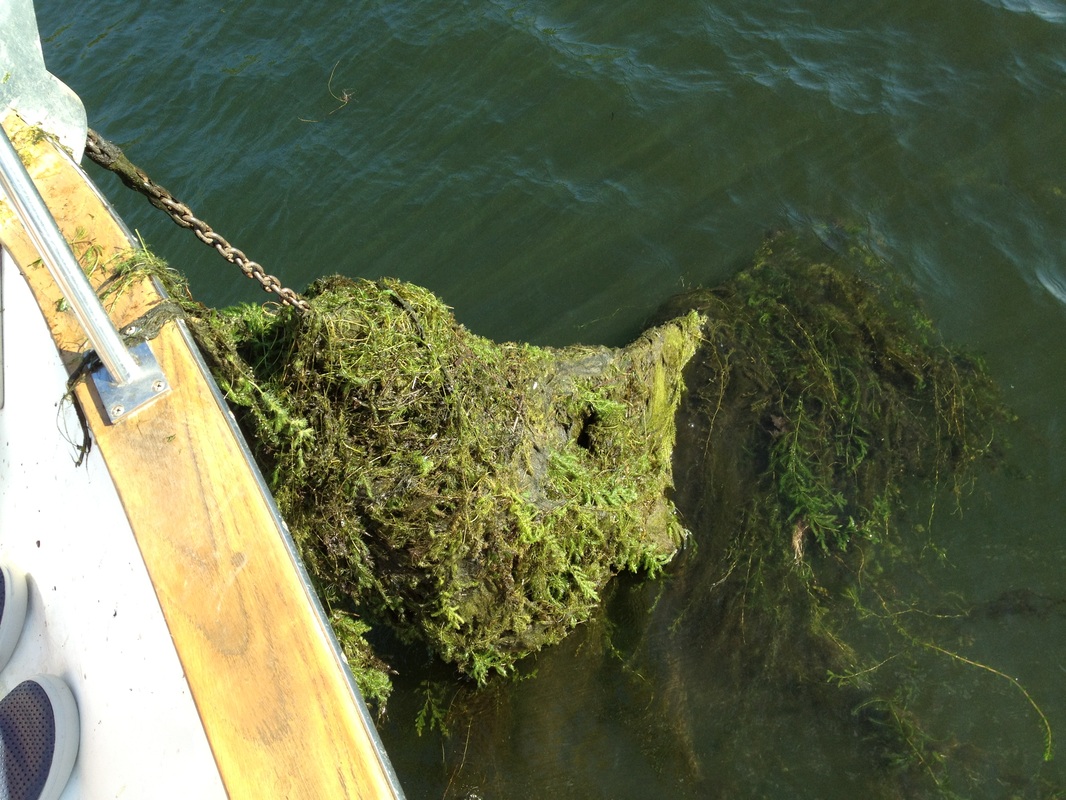 The mass of grass with a 10 foot log underneath it all with the anchor chain wrapped around it. It took over an hour to clear this mess. 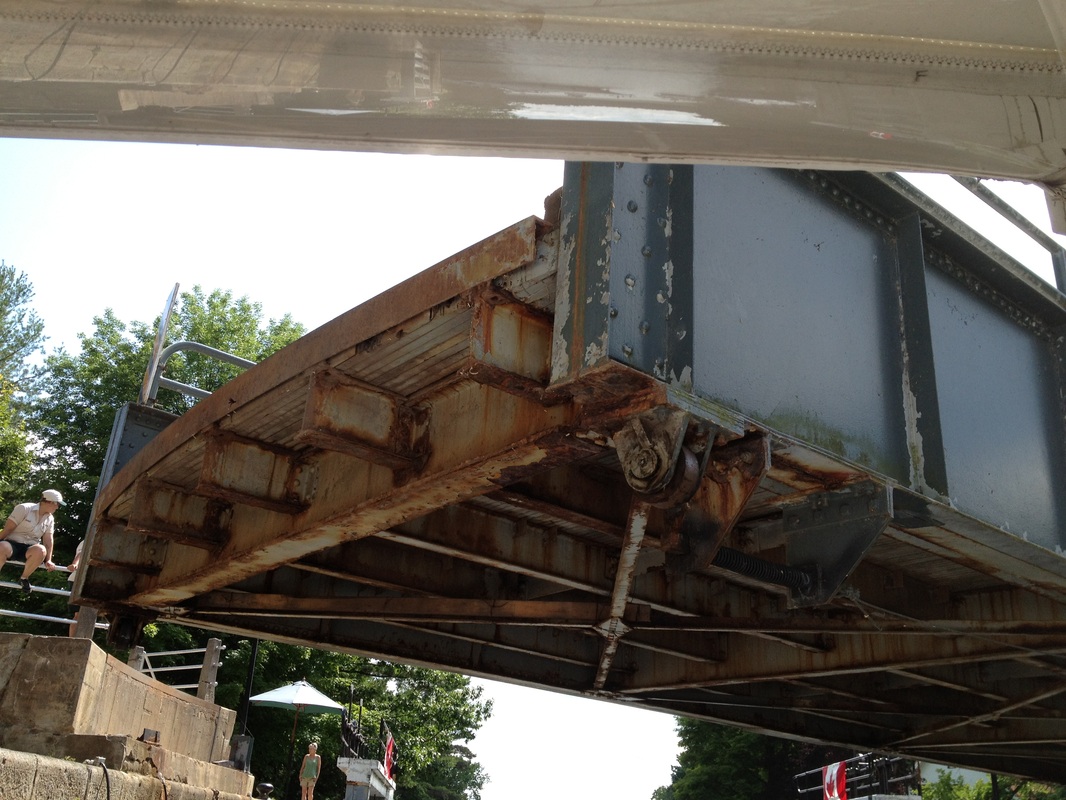 Over this lock was a swing bridge. What we didn't know until after it was time to swing the bridge to let us out, was that the bridge swings in - towards us. It came within 5 feet of our fly bridge. 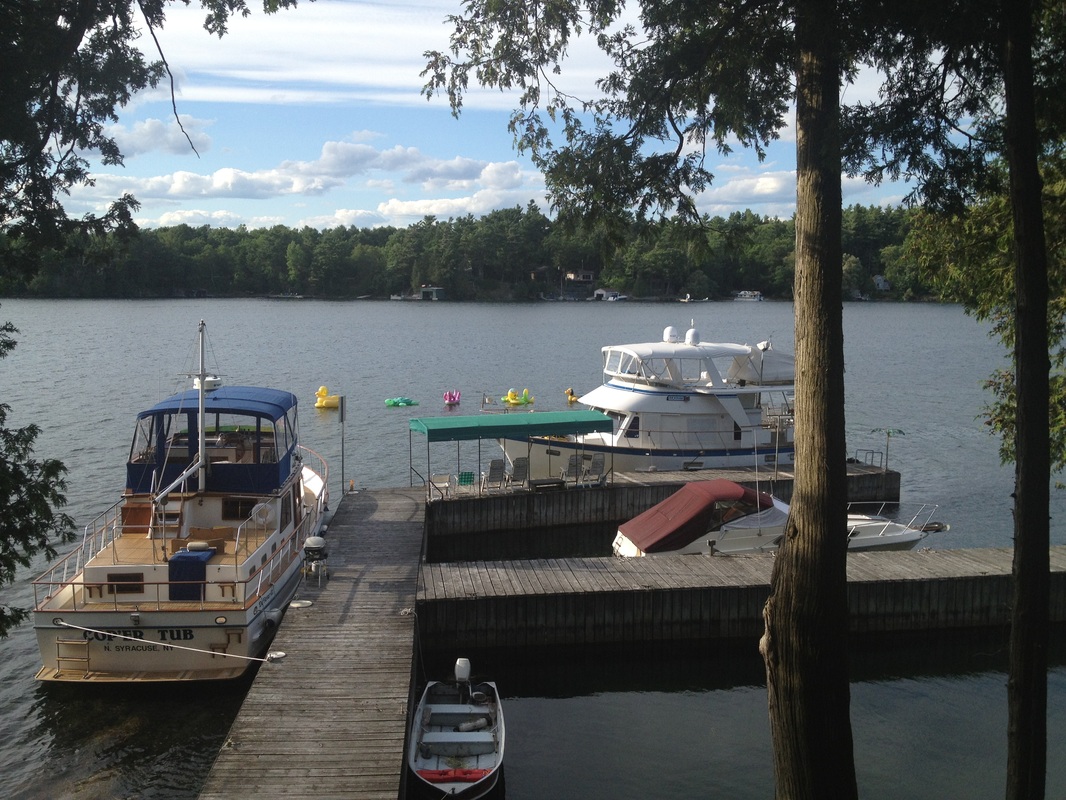 Rickshaw and Cop'er Tub sitting at the Keeler Landing dock. Cop'er Tub is owned by Jim a retired police officer. 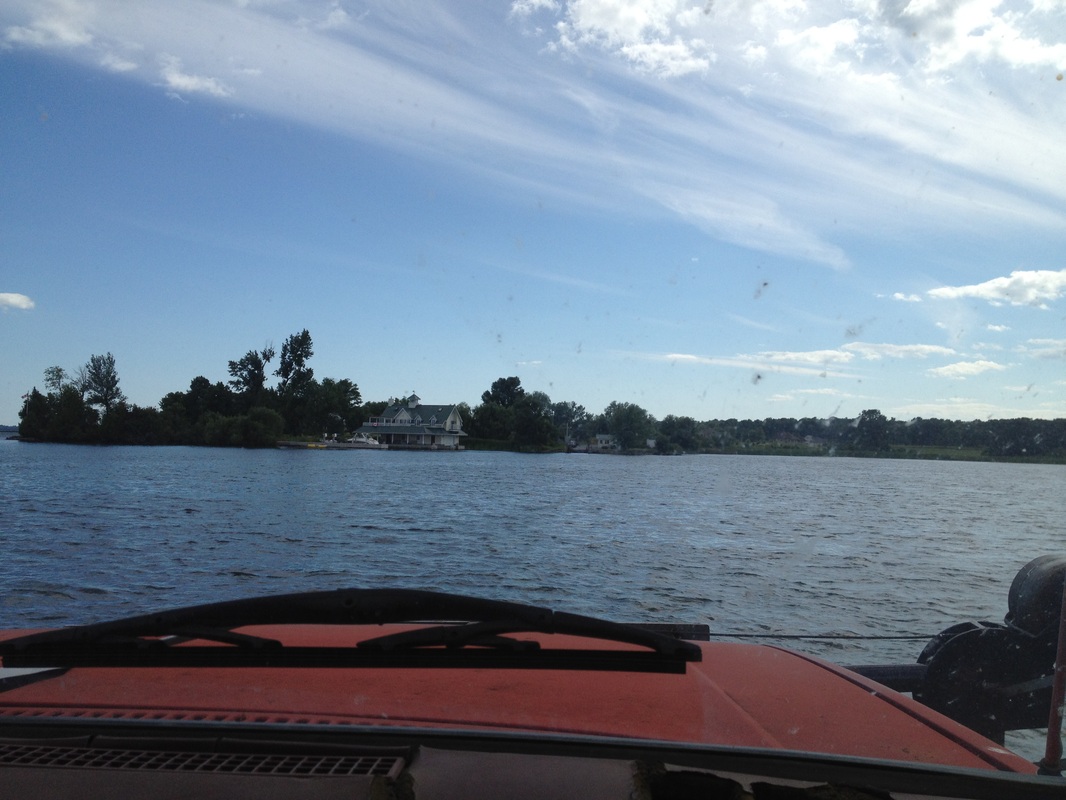 We are cruising the Thousand Islands in a 1982 pick up! Actually we are the first vehicle on a three car cable ferry. Thanks, Ruth & Frank for loaning us your truck to get to the tour boat. 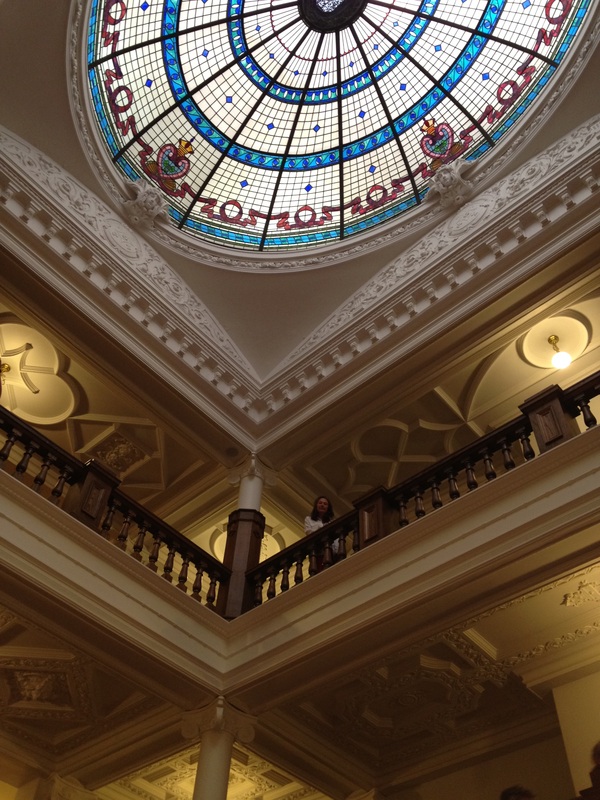 Belinda on the third floor of the entry hall with the stain glass dome ceiling. Beautiful! 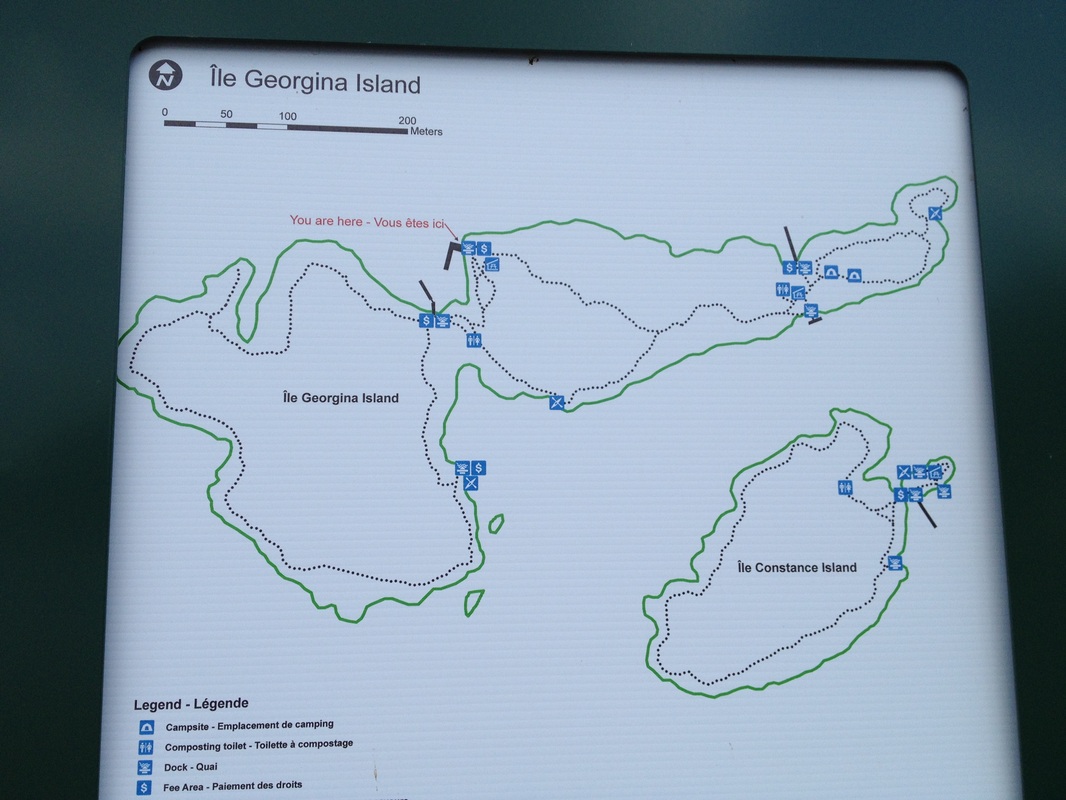 The trail map on Georgina Island. It took 50 minutes to do the complete loop. Lots of hills but the view from the island was beautiful. 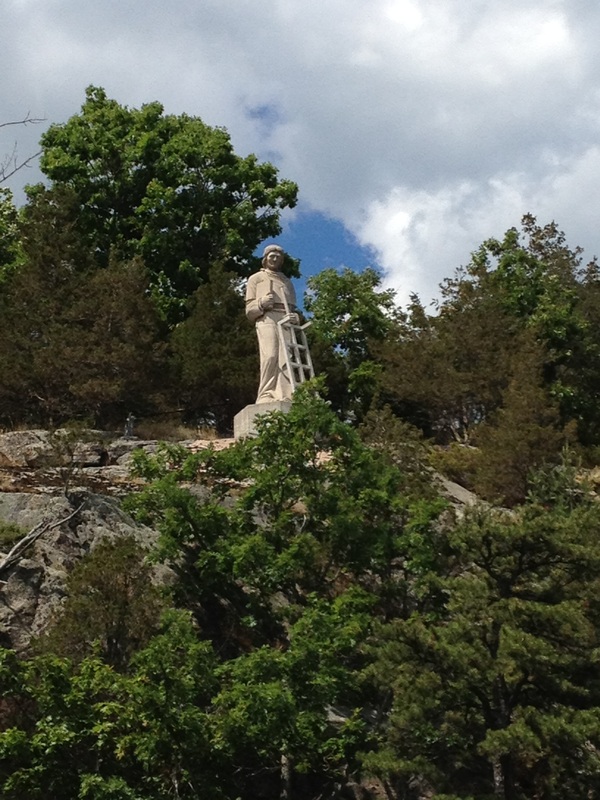 A statue of St. Lawrence on top of a cliff along the river. St. Lawrence is the patron saint of chefs since St. Lawrence was executed on a gridiron. 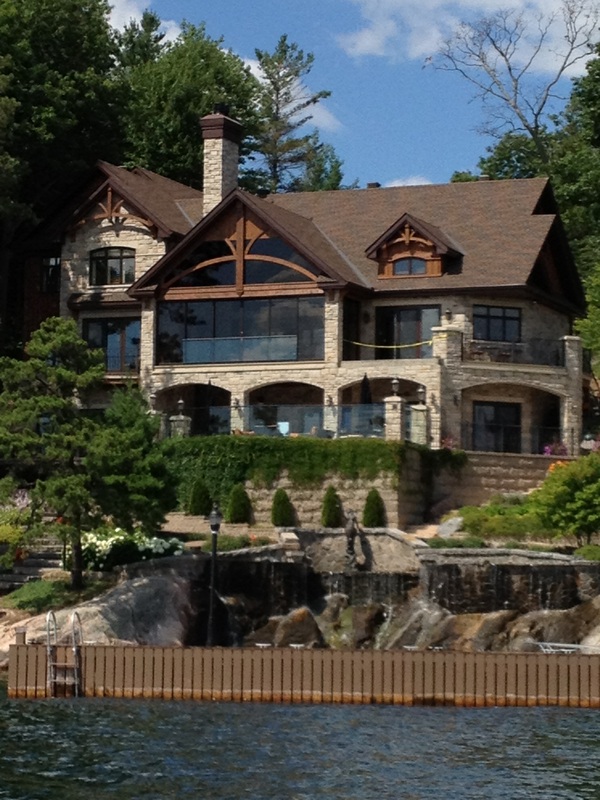 One of the larger homes in the Thousand Islands with a water fall. There is one section that is known as Millionare Alley. Many are owned by old money from New York. | 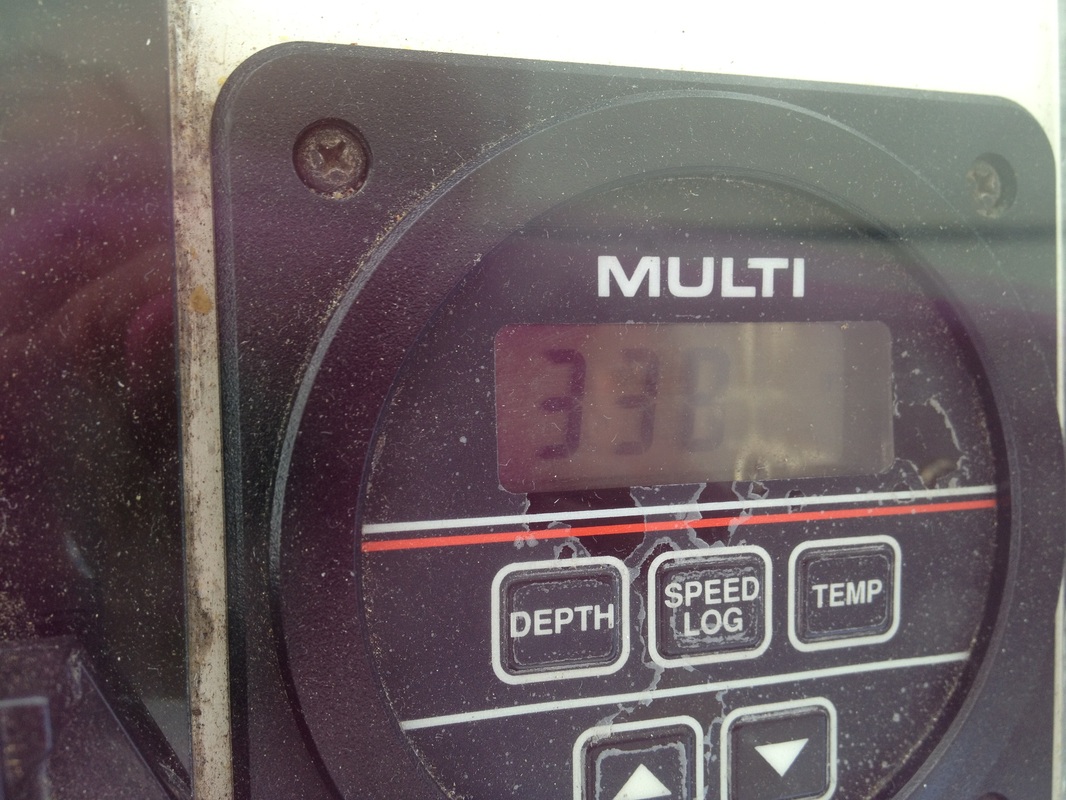 On the Big Rideau River, which is part of the Rideau Canal, our depth meter read 338 feet! 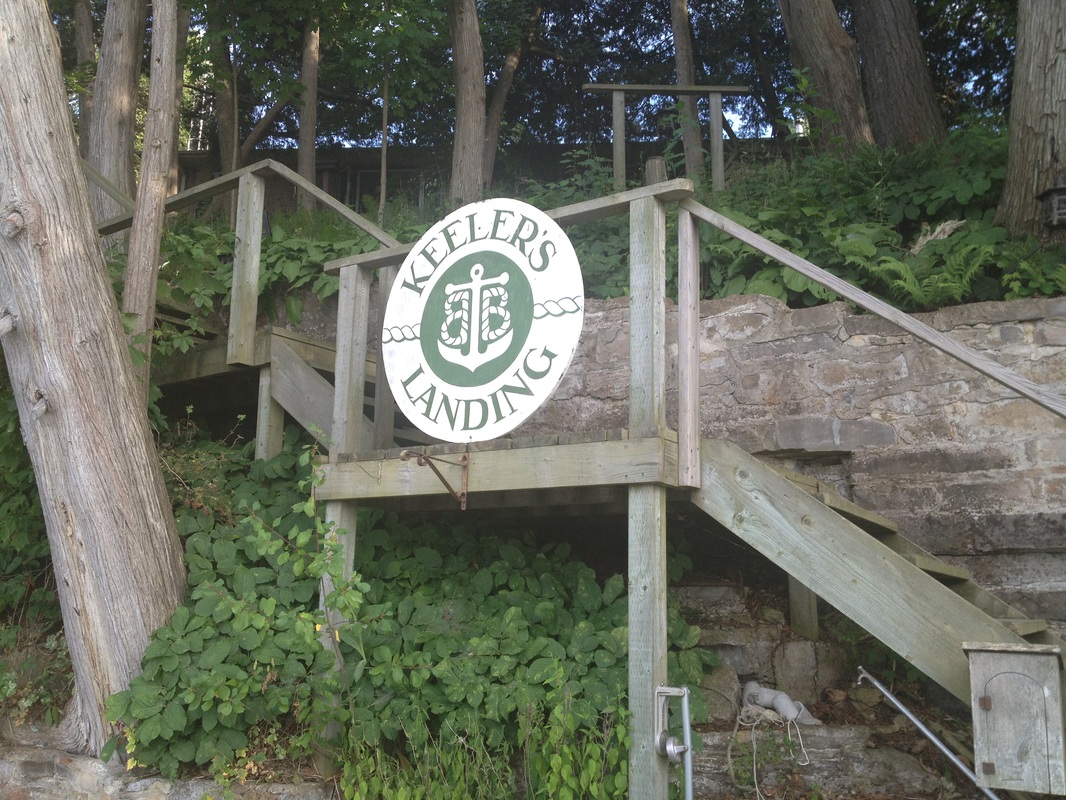 Keeler's Landing! The sign is on the stairs from dock to the beautiful house that overlooks Bateau Channel on the north side of Howe Island 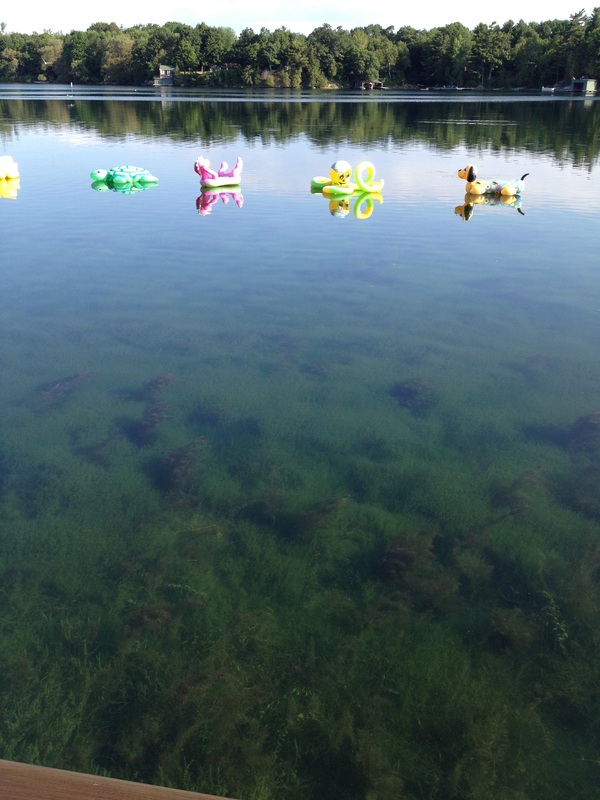 The pool toys that mark the shoal off Keeler Landing. Since the river was still we could see the thick vegetation growing on the bottom that gave us so much trouble in Morton Bay. 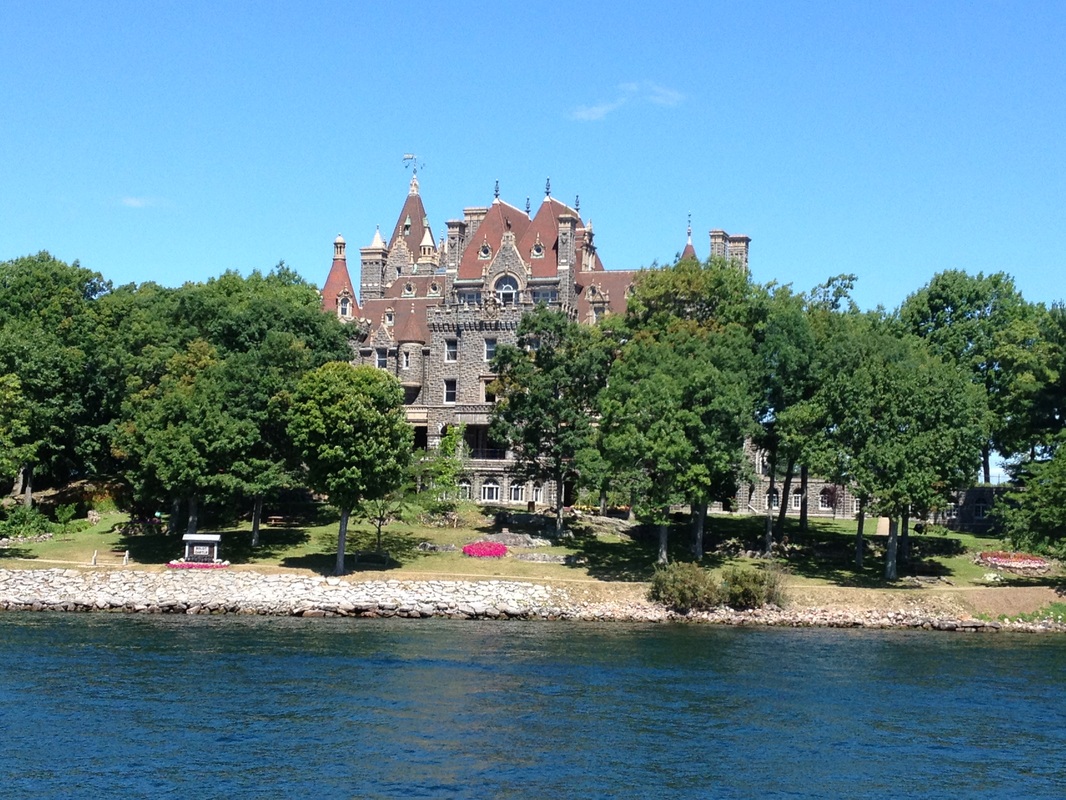 Boldt Castle from the water. The grounds are beautiful. 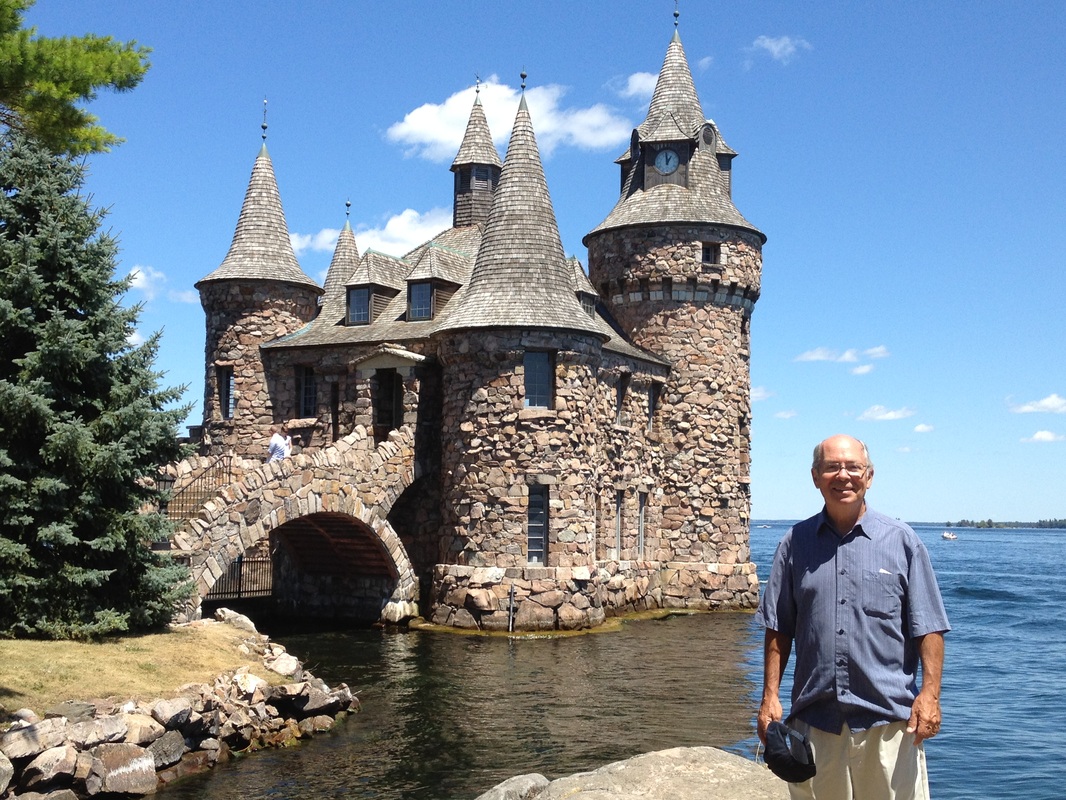 Jim outside the power house. This mini castle houses the engines that generate power for the castle. 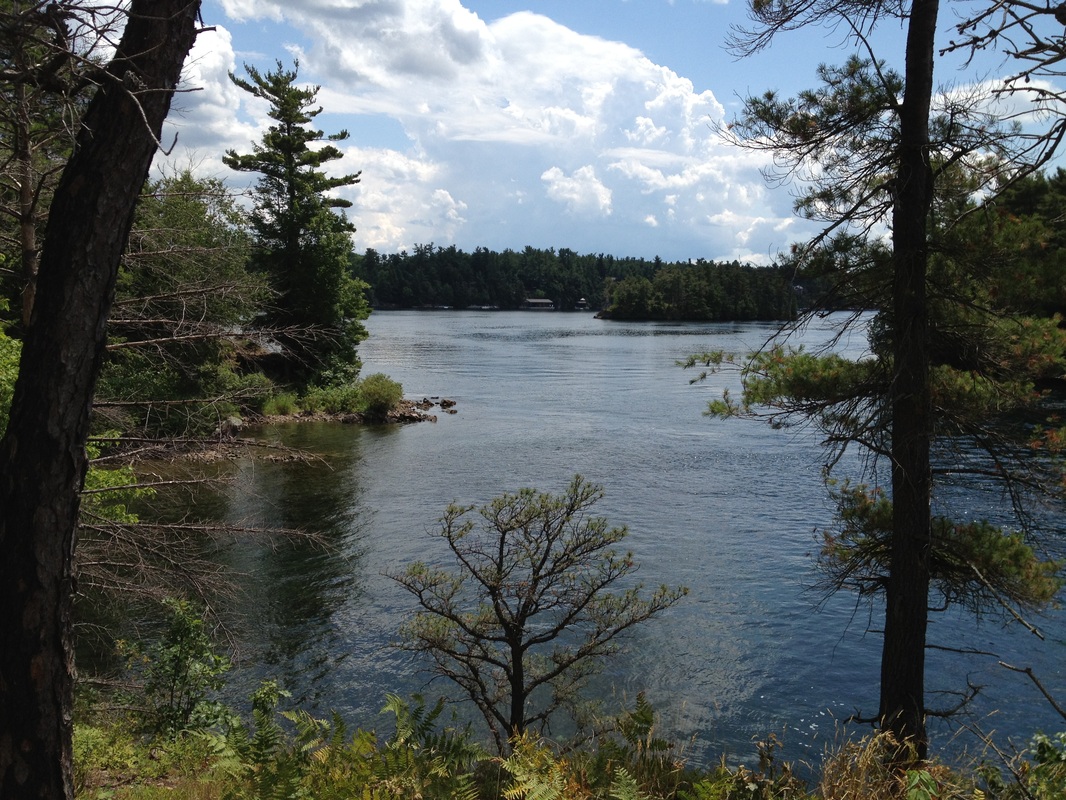 The view from the trail on Georgina Island overlooking other islands in the Thousand Islands. There are actually over 1800 islands in the archipelago. 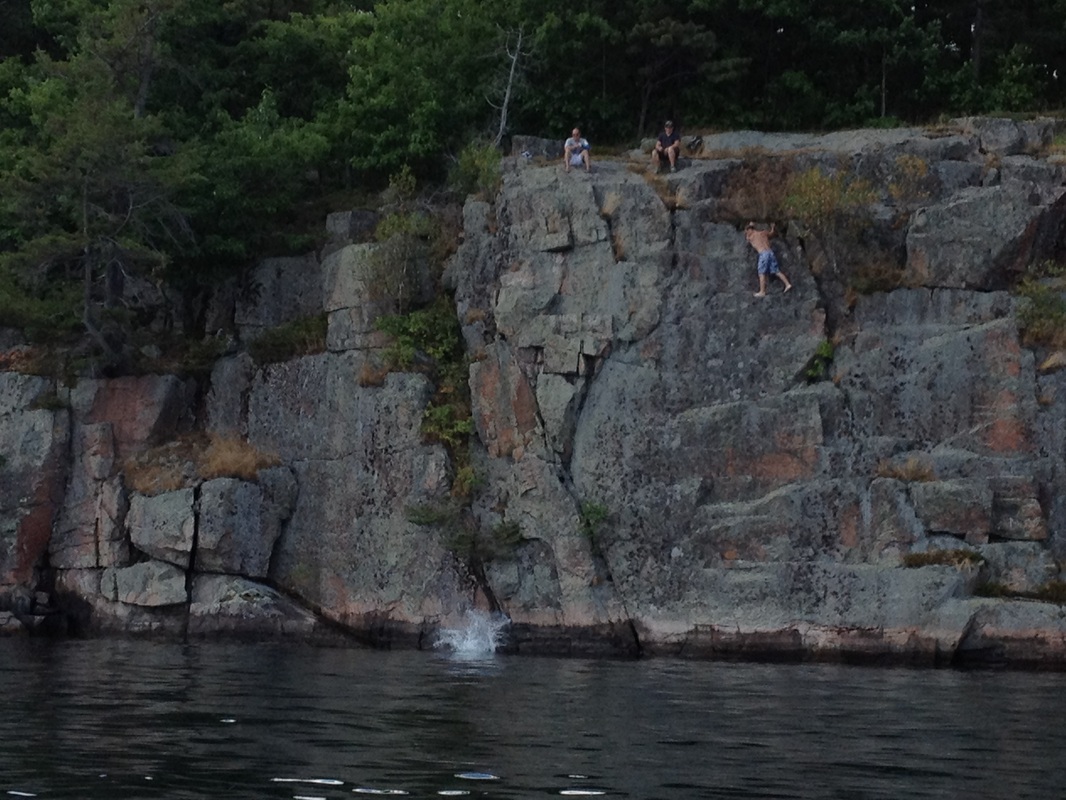 These boys are jumping from the one of the many cliff walls along the St. Lawrence River. 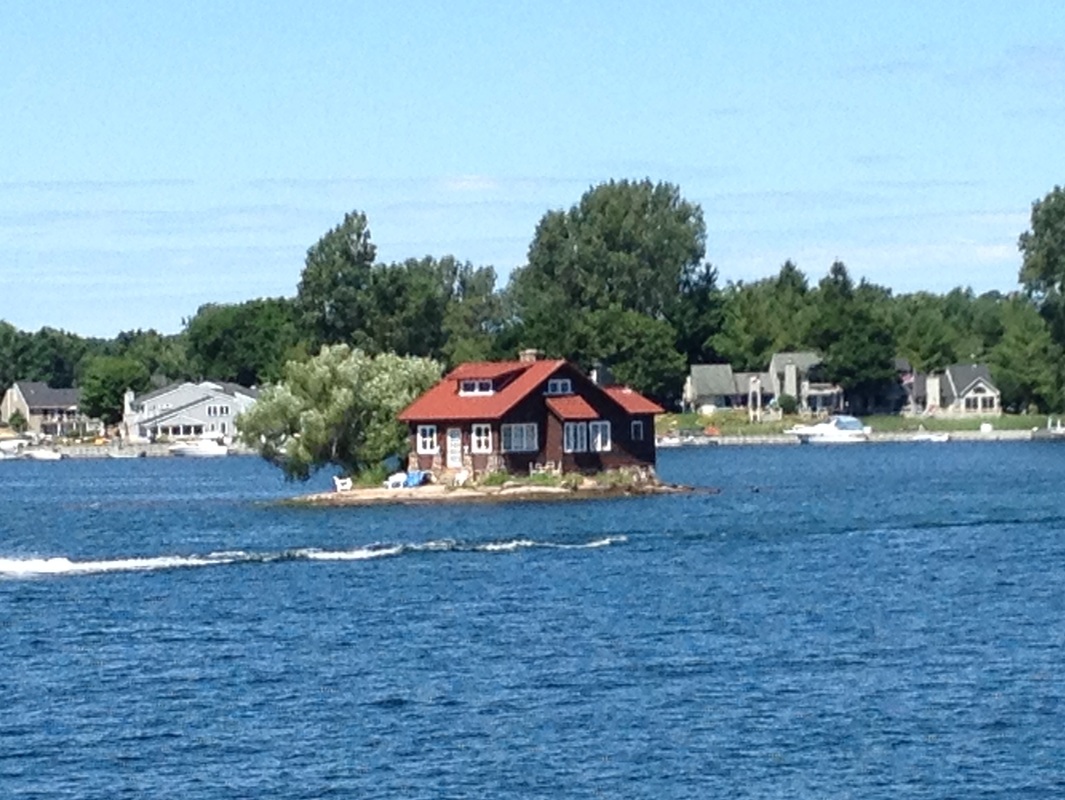 One of the one cottage islands in the Thousand Islands. Most had lots of trees so you could barely see the cottage, but this one was the smallest island we saw with a cottage. 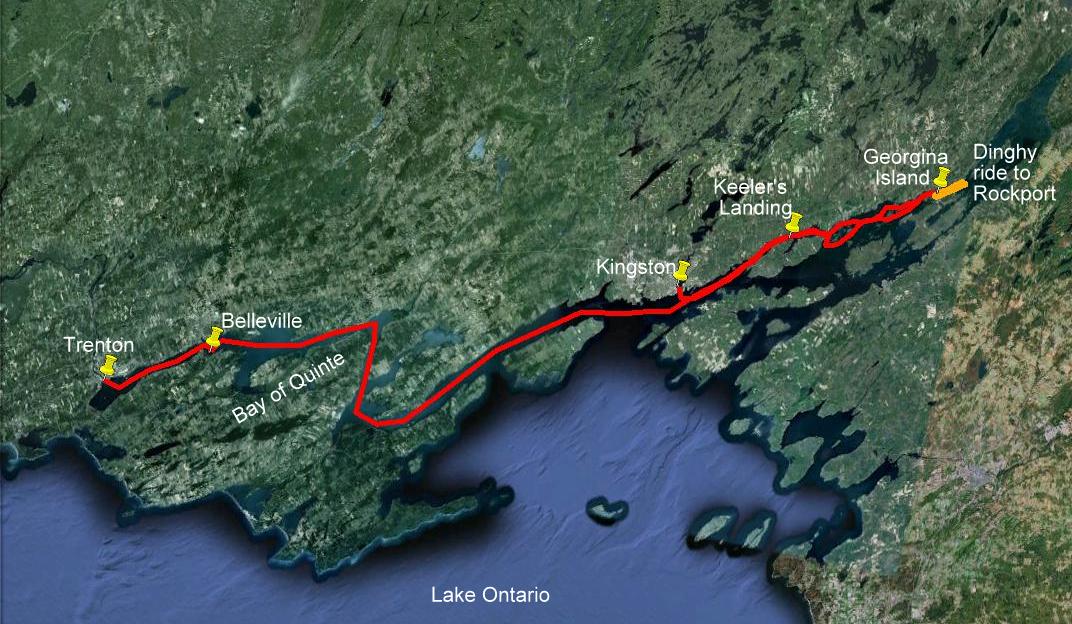 This map covers our track east from Kingston through the western end of the Thousand Islands then arcoss the Bay of Quinte to Trenton. A toltal of 178 miles. |
July 2nd - Day 59: After leaving the lock wall at Poonamolie, we travelled north to our destination, Merrickville, just 15 miles up the canal. Merrickville had the reputation for being quaint with several antique and nick-nack shops lining the main streets. One of the curious things we’ve noticed about Canada is their “appreciation” for country music, e.g. at a café we stopped at to eat lunch, there was a trio that started off the set with “Your Cheating Heart”. The further up the canal we went, the more we ran into French-Canadians who came down from Quebec to enjoy the canal on their 25 ft sport cruisers. In Merrickville, we were the only non-French boat at the dock, and managed to get the last spot at the dock. Because we had bought an annual Parks Canada mooring pass, we are able to stay at lock walls for no charge, allowing us to save a few dollars for higher cost marinas in other spots along our trip.
July 3rd - Day 60: We reversed our track today, heading back down the Rideau to one of the “larger” towns in this part of Ontario, Smith’s Falls, so we could let Rickshaw rest for a couple of days, while we hopped on the train to visit Ottawa, which was 40 miles north of Smith’s Falls. Since we were going back through all of the same locks we had gone through on the way up the canal, we knew what to expect and the lock experience seemed to go much better.
July 4th - Day 61: At 9am on our Independence Day in Smith’s Falls, Belinda put on her stars and stripes shirt, and we unloaded our folding bikes off of the aft deck and pedaled the 3 miles to the train station for our 10am train to Ottawa. Upon arriving in Ottawa, we inquired about local bus service to downtown Ottawa and managed to find the correct bus which took us to the heart of the capital city. We had read that a couple of looper friends, Bill & Joyce on Carried Away (from Williamsburg) who we met on the Hudson, were in Ottawa on their boat, so we went down to the canal in the city center, and found them relaxing on their aft deck, having just gone up the 8 step locks in Ottawa. Since Ottawa is the capital of Canada, and considers Queen Elizabeth to be their monarch, the British influence can be seen everywhere including the governmental buildings which resemble those in London, and the queen’s guards in red suits and bearskin hats, like those in London. Since we had a relatively short day on the first day (since we didn’t arrive until almost noon), we used the rest of the day to visit the large farmers market area next to downtown, where Belinda found the local delicacy that she had been told had to be tried while in Canada – fried beaver tail, which is really a variation on a funnel cake in the US. Toward the end of the day, we went to the centerpiece of the Canadian governmental complex, Parliament Hill, which houses the legislative branch of the Canadian government, including the House of Commons and the Senate, and were able to jump on the final tour of the day. Our return train to take us back to Smith’s Falls left shortly after 6pm, so, following the parliament tour, we hopped on another city bus and caught our train back.
July 5th - Day 62: One of the “must do’s” in Ottawa is to watch the changing of the guard in front of Parliament Hill, which happens each morning at 10am. Since the morning train did not arrive in Ottawa until noon, we opted for the 7am Greyhound bus from Smith’s Falls into Ottawa, which took 90 minutes to cover the 40 miles into Ottawa. So, we hopped on the bikes at 6:15 am, and made our way to the bus station. The daily ceremony was very elaborate complete with marching bands, bagpipes, and a couple of hundred red-coated guards marching from down the street, through the front gates, and onto the front lawn of the parliament building in strict formation. Following the changing of the guard, our next destination was the local marine supply store to buy a few new docklines that were needed to make Belinda’s job as the linehandler in the locks a bit easier. Unfortunately, the one we needed to go to was outside of town, so our challenge was to figure out the local bus service, and where and when to catch the correct bus to get us at least close enough to walk to the marine store from the bus stop. Two hours later, we had found the lines we needed, found the correct bus to get us back to the city center, and returned to town for our next to-do of the day, a hop-on/hop-off tour of the city on a double-decker bus. The bus gave us the opportunity to see parts of the city not accessible by our normal means of transportation, walking or the city bus, including a lot of the museums and foreign consulates. We were very impressed with Ottawa and, to some degree, regretted that we had not come up via Rickshaw to see the city. But, the entire Great Loop is a multitude of tradeoffs of what to see and what to skip along the way, so, in the interest of time and not wanting to shortcut other parts of the trip, we had decided to visit Ottawa via a quicker form of transportation than a trawler provides. At 6pm, we took the train back to Smith’s Falls, picked up our bikes from the bus station down the street from the train station, and returned to Rickshaw, exhausted after a very long day.
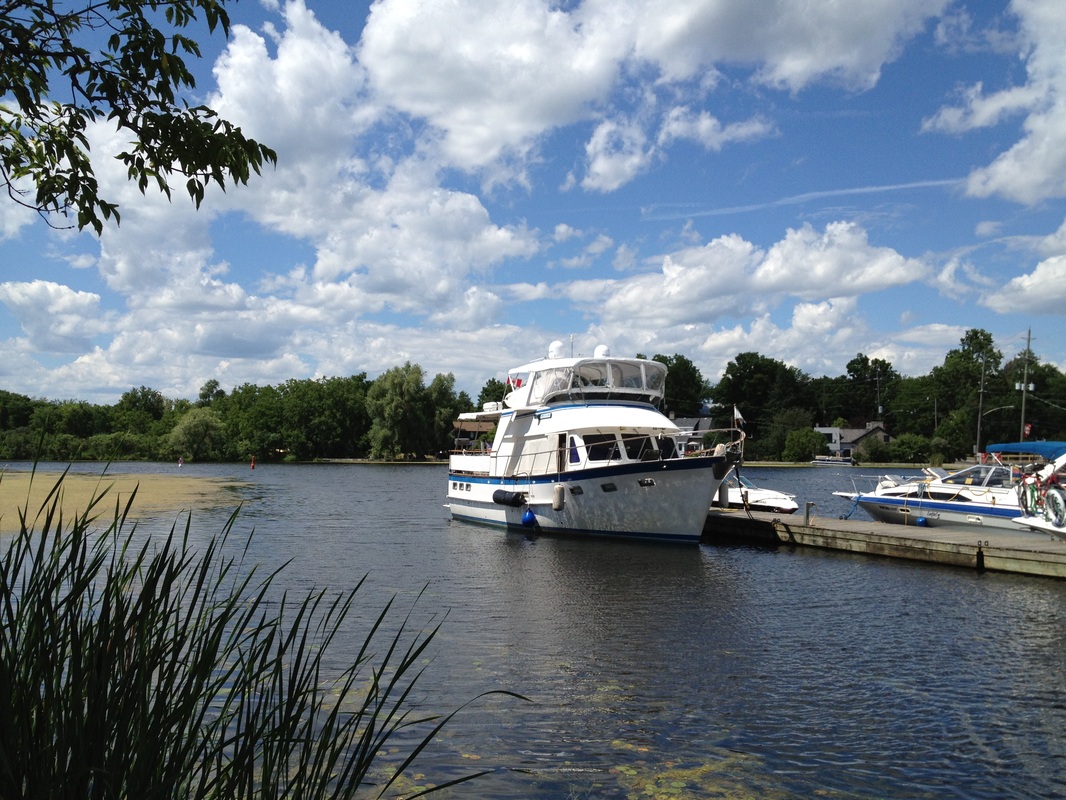
Rickshaw in Merrickville - this is the farthest we will go on the Rideau Canal.
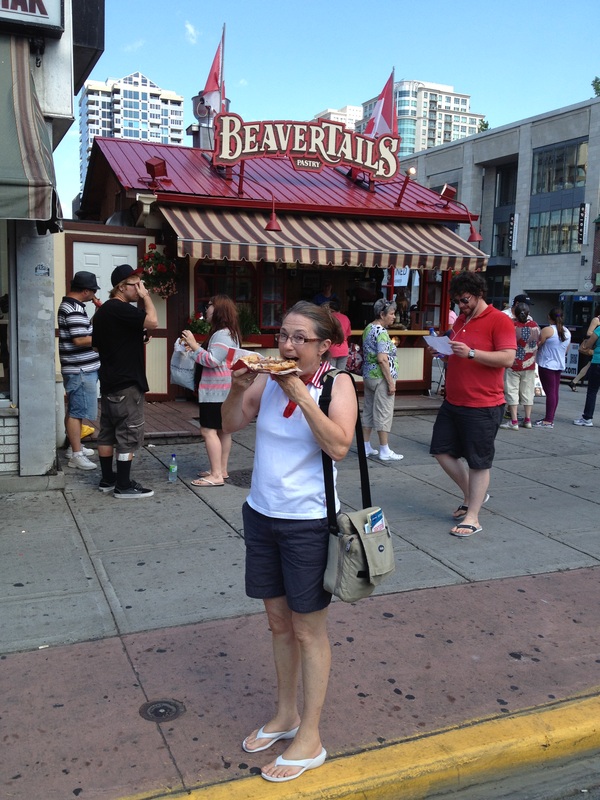
Belinda eating a fried beaver tail - a Canadian delicacy!
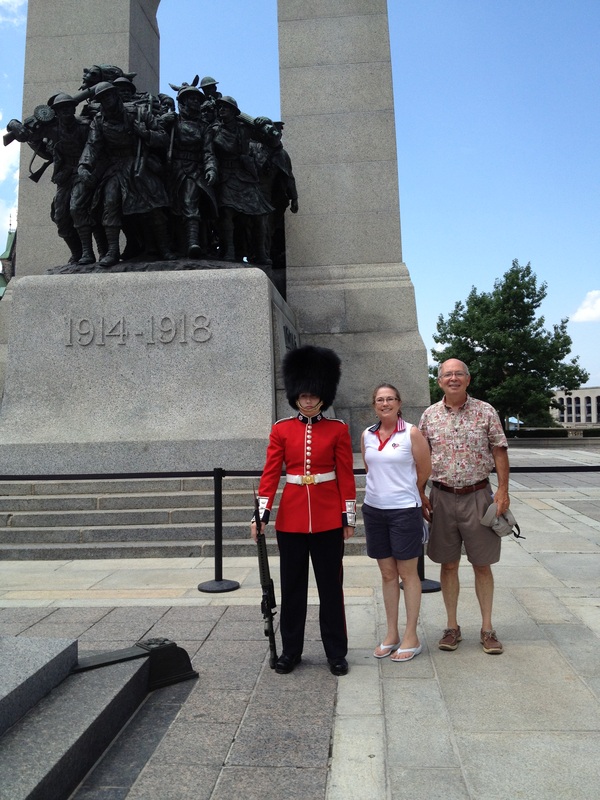
Belinda and Jim standing with one of the Royal Guards at the War Memorial in Ottawa.
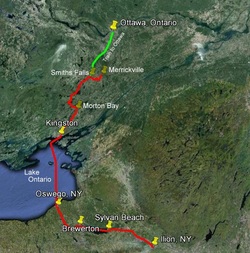
Since the last track map we have traveled from Illion NY to Merrickville, Ontario then back tracked to Smiths Falls - a total of 218 nautical miles.
|
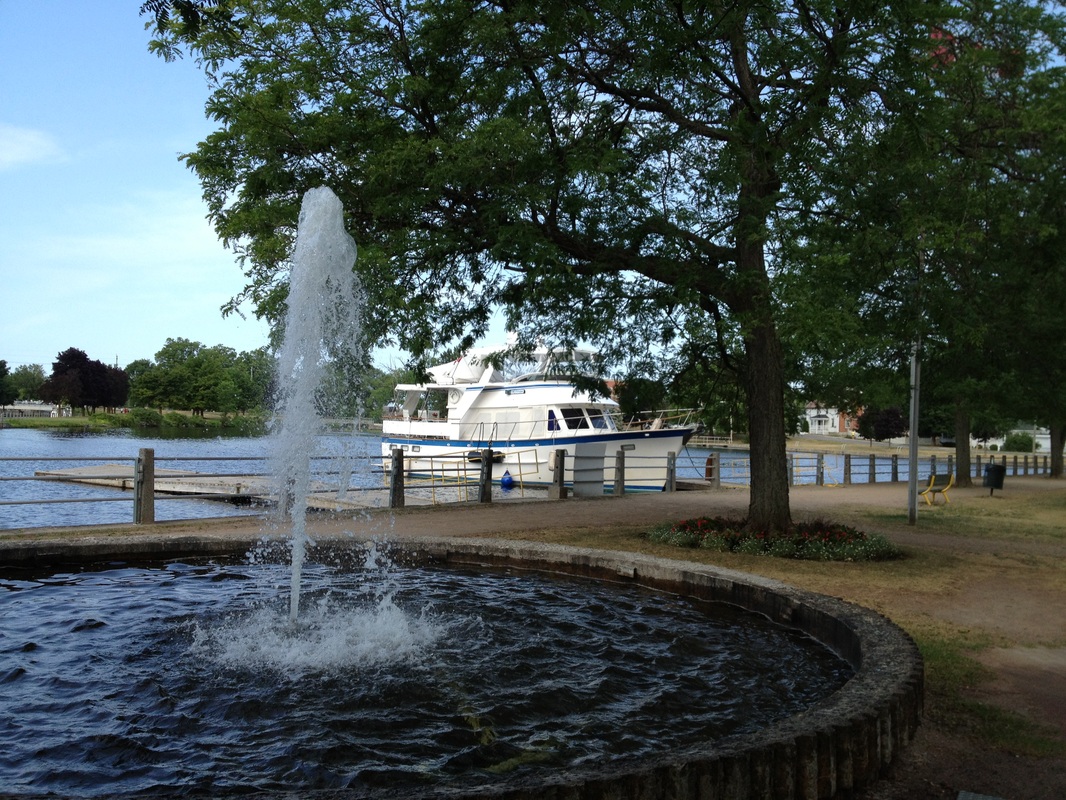
Rickshaw docked at a pretty town park in Smiths Falls. She got to rest while we visited Ottowa by train.
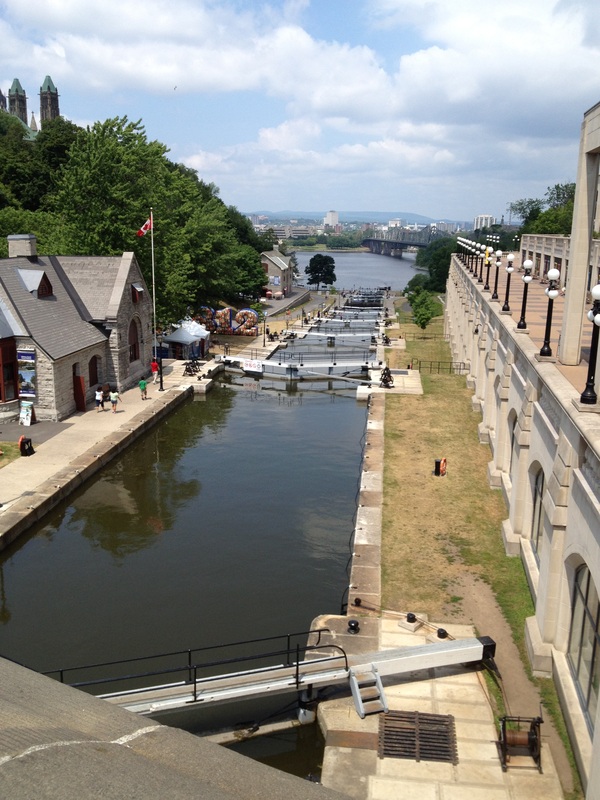
The eight step locks in downtown Ottawa.
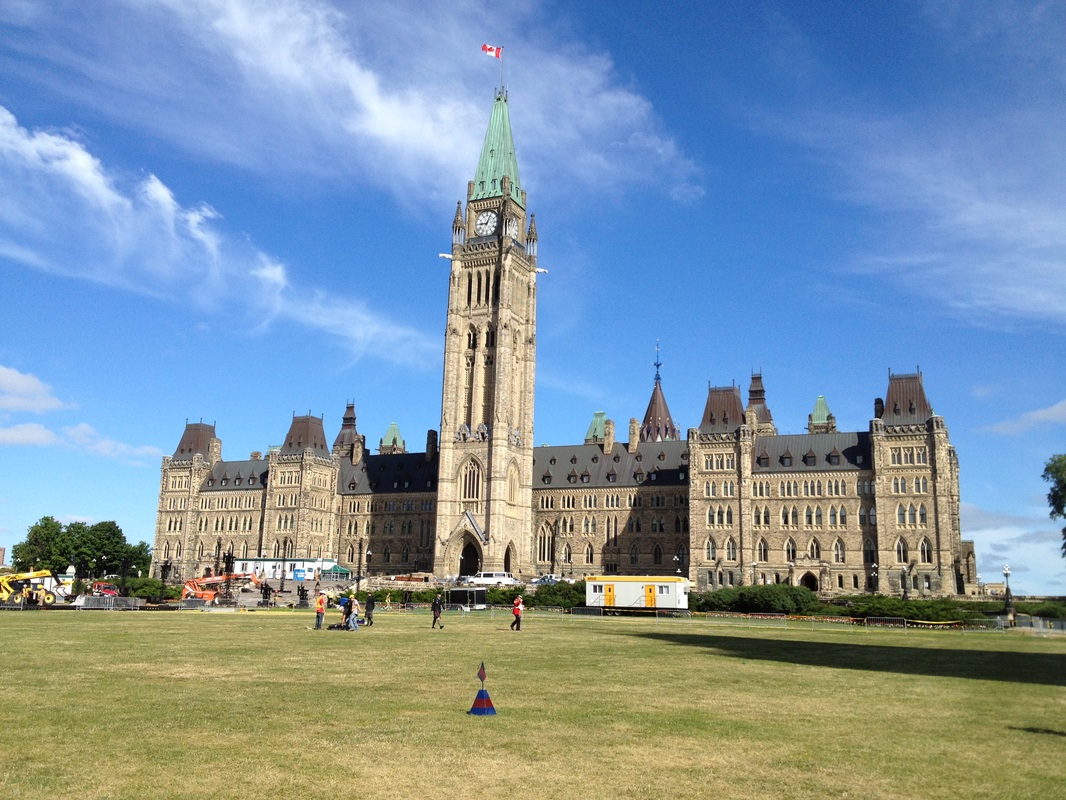
The Canadian Parliment building in Ottawa.
|
Sunday, July 1 - Day 58: We awoke in the “smooth as glass” anchorage in Morton Bay, and proceeded to pull up the anchor around 8am, trying to get going as soon as possible in order to meet up with another looper boat, Quest, heading our way south down the Rideau. We were supposed to meet them about 7 miles up the canal, so we had told them it would take us no longer than 2 hours to get there which turned out to be very optimistic. As the anchor chain broke the surface, we noticed that the chain was growing in diameter significantly with every foot. The anchor and chain had managed to collect several cubic feet of weeds and mud during the night. By the time Jim was able to cut, chop, pull, and spray off (with the water hose) enough of the chain to get the anchor close to the surface, the mass had grown to be 4 feet in diameter, with the anchor completely hidden somewhere in the middle of the glob of gook. So, getting away from the anchorage took a bit longer than we had expected.
Two miles up the canal we came to our first lock of the day, which was actually a 3 step lock (3 locks with one leading into the next one). Unfortunately, the lock chamber was already full with other boats when we arrived, and the lockmaster told us that it would be another hour & ½ before all of the boats could be raised up to the upper level, and then the water drained back down to our level to let us have our turn. (Being a relatively large boat compared to other boats that go up the Rideau means that we don’t fit into the locks with many other boats, since our beam pretty much takes up half of the width of the chamber). As predicted, about an hour and half later, the bottom lock gates swung open and we were allowed to enter. We finally did meet up with Quest around noon at one of the locks further up the canal, and enjoyed a quick lunch on their boat after tying up below the lock on the public wall. When we came up to the wall to tie up, we were assisted by the crew of Quest and a local boater who took my bow line and “secured” it to the cleat on the dock. Towards the end of our lunch, Carl (the skipper of Quest) jumped out of his chair on Quest’s aft deck, and screamed “your boat is not tied!!!!”. Jim looked back to see Rickshaw almost perpendicular to the dock, having been pushed away by the rush of water coming out of the lock chamber. Jim was able to climb aboard Rickshaw’s stern and start the engines, while Carl & the lockmaster grabbed the lines (just short of the bow line leaving the dock for good) and muscled Rickshaw back against the dock while Jim maneuvered the boat back into position with the engines. Lesson reinforced – always check the security of lines tied to the dock by others.
Belinda & I continue to refine our system for working together efficiently and through much trial and error are slowly working out the kinks. But, it has been verrrry frustrating for Belinda, especially since she doesn’t have the upper body strength or the arm length to make up for Jim as the boat driver being anywhere but smack against the wall and right up against the correct cable. In other words, a chimpanzee would be great as a line-handler. Another factor which makes this challenging for both is that our boat is very heavy, has very high freeboard above the lock walls at the top, and the lines that we have been working with are very heavy and beefy, therefore very difficult to throw, tie, wrap, etc.
Most of the rest of the day was spent going through more locks (8 more in total), snaking down very narrow streams, where we had less than a foot of water under our keel and had only 2 or 3 feet on either side of the boat before being in 2 feet of water, and crossing beautiful lakes. (We did, in fact, hit several hard objects in the middle of the channel throughout the day). At one point in a narrow channel, we came up to an approaching southbound sport cruiser (about 25 ft length) and weren’t sure that the channel was wide enough for us to pass without one of us pushing the other into the overhanging tree branches. One of the lakes we traversed was the 20 mile long Big Rideau Lake, which is a very popular summer recreation lake, surrounded by vacation cottages. It reminded us of lakes in the Arkansas Ozarks with its clarity and depths that were over 200 feet at times, and at others, were less than 10 feet.
Because of our delays earlier in the day, we were not able to make our intended stopover for the day, Smith’s Falls, but instead stopped at the Poonamalie Lock, which was at the end of one of those windy, remote, narrow channels. The grounds surrounding the lock were pristine, with manicured flowerbeds all around the lock, and in the middle of woods with lots of chirping birds. It seemed like we were in a state or national park which was in the middle of a wilderness. Unfortunately, we were not able to sit out on our aft deck too long because the mosquitoes came out in droves close to dusk so we were chased indoors for the rest of the night.
After a very frustrating day dealing with the locks, especially for Belinda, we decided to adjust our cruising plans a bit, and not take Rickshaw the remaining 100 miles to Ottawa, especially since the reputation of the upper Rideau is that it can be very shallow and weedy, and not as pretty as the lower part. So we checked out the train & bus schedules and found that Smith’s Falls, which was only a few miles further up the river, had both bus & train service into Ottawa. So, our new plan was to go beyond Smith’s Falls to Merrickville (which was supposed to be a really quaint little mill town), stay the night, and then return to Smith’s Falls on Wednesday, 7/3, so we could hop on the train on 7/4 to see Ottawa and let Rickshaw rest for a couple of days.
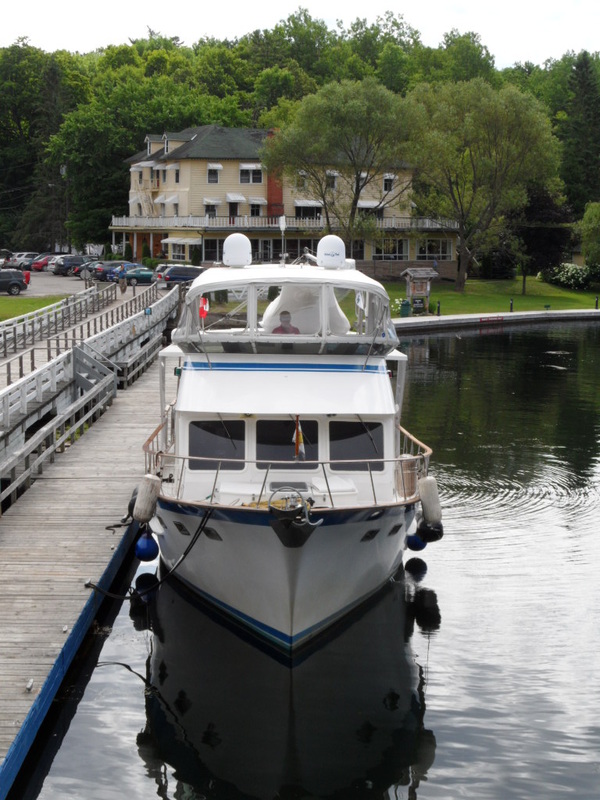
Jim on Rickshaw waiting to go through the Jones Falls Locks. There are three locks in a series due to the high elevation change.
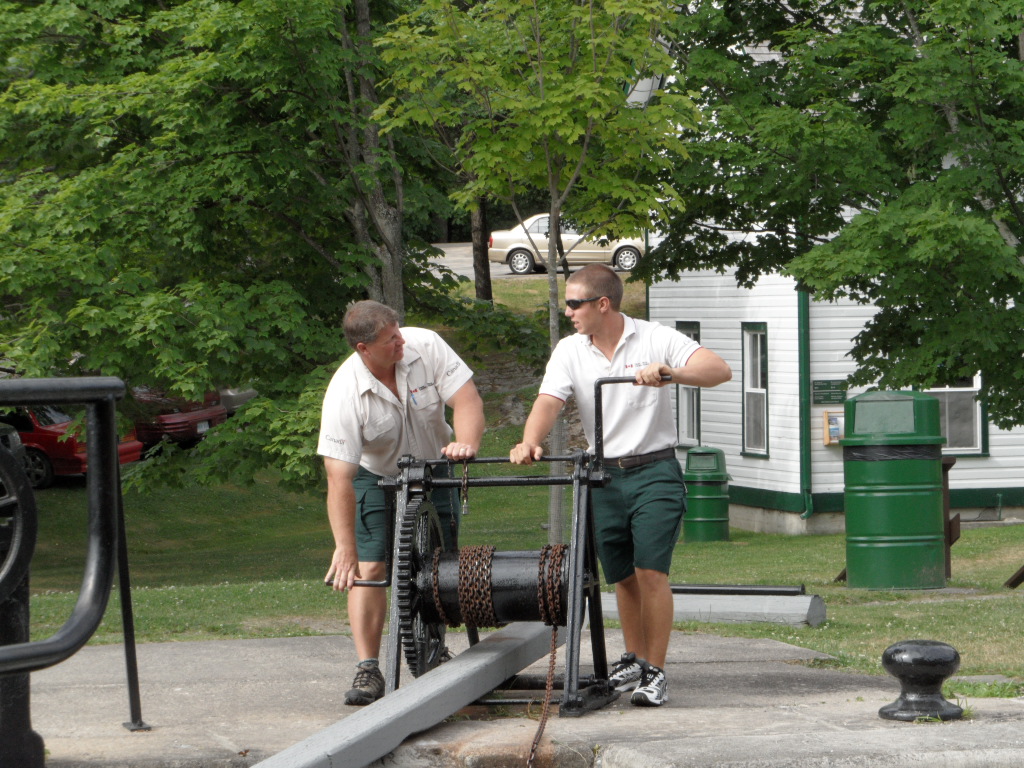
Two of the lockmasters hand cranking the lock gates open. All of the lock gates and lock valves are operated by hand.
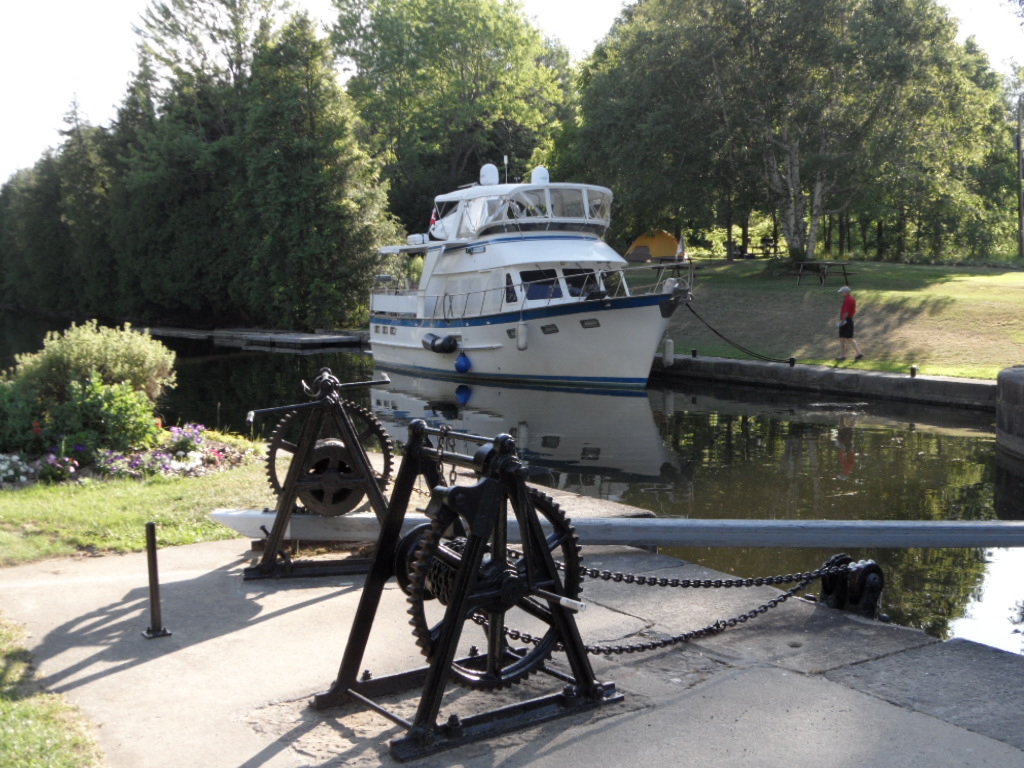
We spent the night here on the lock wall in Poonamali, Ontario.
|
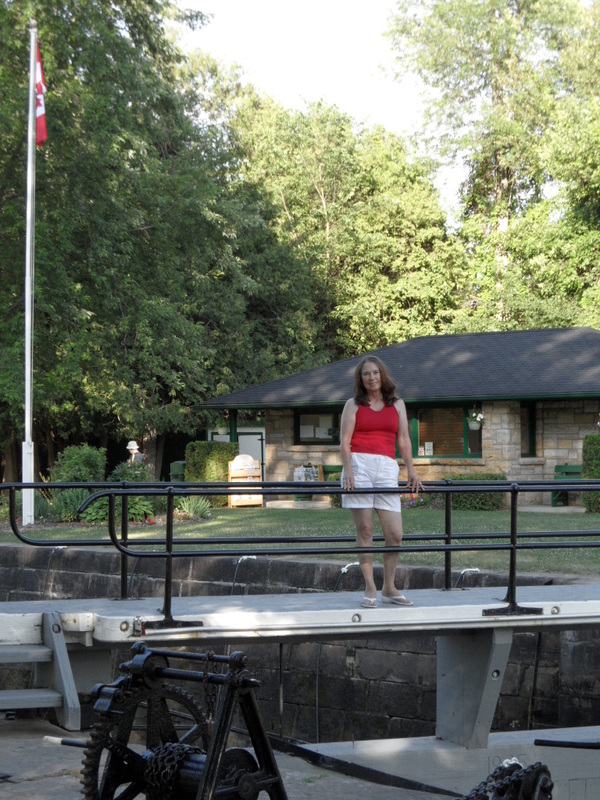
Belinda standing on a lock gate. Since it was Canada Day we both wore red as did most Canadians.
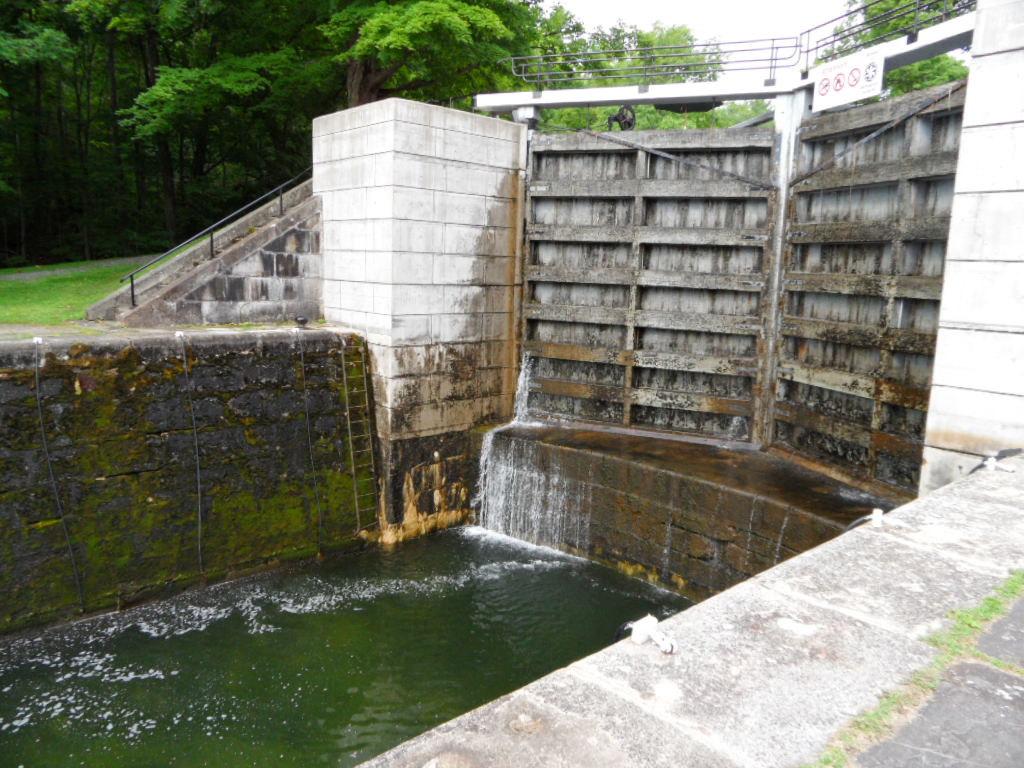
This is one of the locks gates in the flight of three locks at Jones Falls Locks.
|
Saturday, June 30 – Day 57:
We dropped our lines from the Kingston Marina, and headed up the Rideau Canal towards Ottawa, 128 miles away. The Rideau Canal was constructed in the 1820’s primarily as an alternate military route between Lake Ontario and Montreal just in case Canada’s enemy to the south ever captured the St. Lawrence River. It consists of a system of beautiful rivers and lakes connected by 49 locks. Today, the Rideau is used primarily by pleasure boaters, cottagers & tourists. All of the locks on the canal are operated by hand via various systems of gears, pulleys and ropes, mostly by young teenage & college-age students supervised by an adult at each lock. At many of the locks, local townspeople come down to the picnic tables at the sides of the lock chambers, with picnic baskets, and watch the show of the boaters trying to maneuver the boats of various sizes and lengths through the locks. Some of the locks are multi-level, (called flights), to break up the elevation difference among several chambers, so that when you leave one lock, you immediately enter the next lock. The 7 locks that we did today, even though charming and nostalgic, tested Belinda’s patience to the max because the lock chambers were extremely small with lots of turbulence and required quick securing of Rickshaw fore & aft else we might end up sideways in the lock. As you know, Belinda is very petite and has (according to her) very short arms to enable her to quickly grab the cables hanging down the chamber walls while Jim attempts to keep Rickshaw close and parallel to the lock walls. The rivers and lakes between the locks were very picturesque and, at times, appeared to be in the middle of a wilderness with only a few summer cottages peeking through the dense forest. We decided to call it a day after only 25 miles at Morton Bay, which was a very protected & scenic anchorage surrounded by steep granite walls within just a short distance to our anchoring spot. Since tomorrow is Canada’s independence day, Canada Day, there were several ski-boats, pontoon boats and wave runners in the bay, but by 5pm, all other boats except for one other cruiser had pulled up their day anchors and headed back to their summer cottages, leaving the bay almost completely deserted. It was great after so many nights in marinas and town dock walls to finally be able to sleep under the stars with the windows open, feeling the cool lake breezes blowing through the aft cabin.
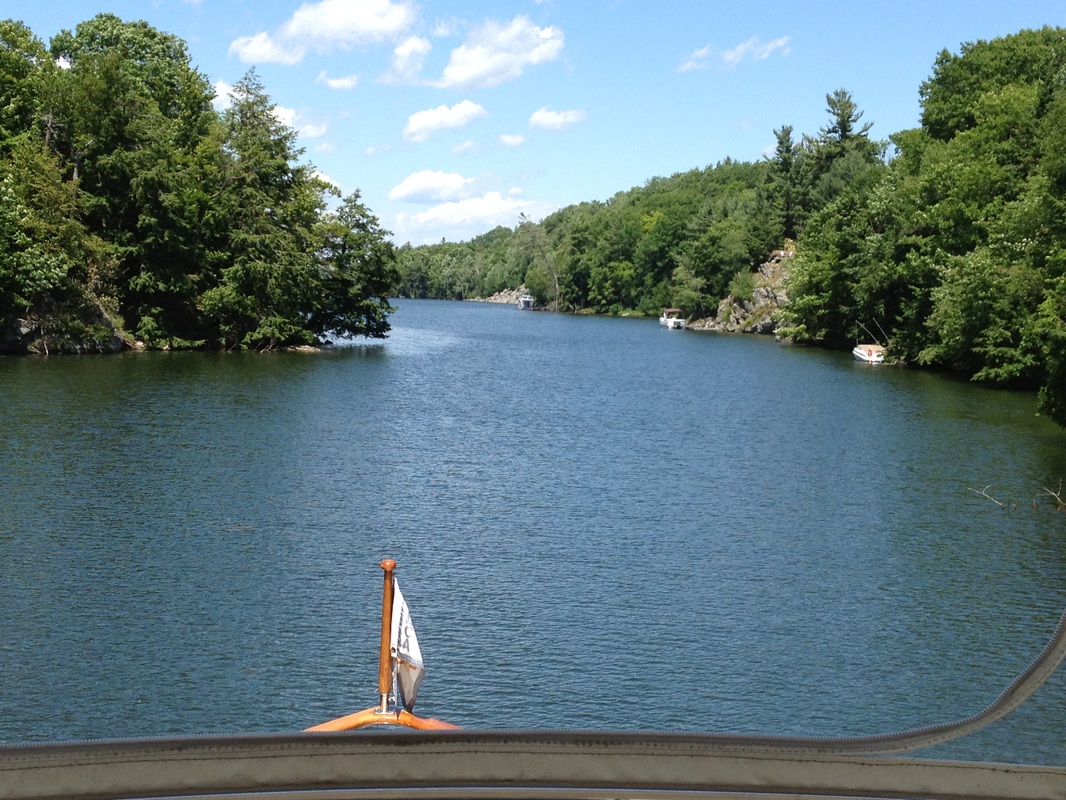 Parts of the Rideau Canal are narrow and windy ...... 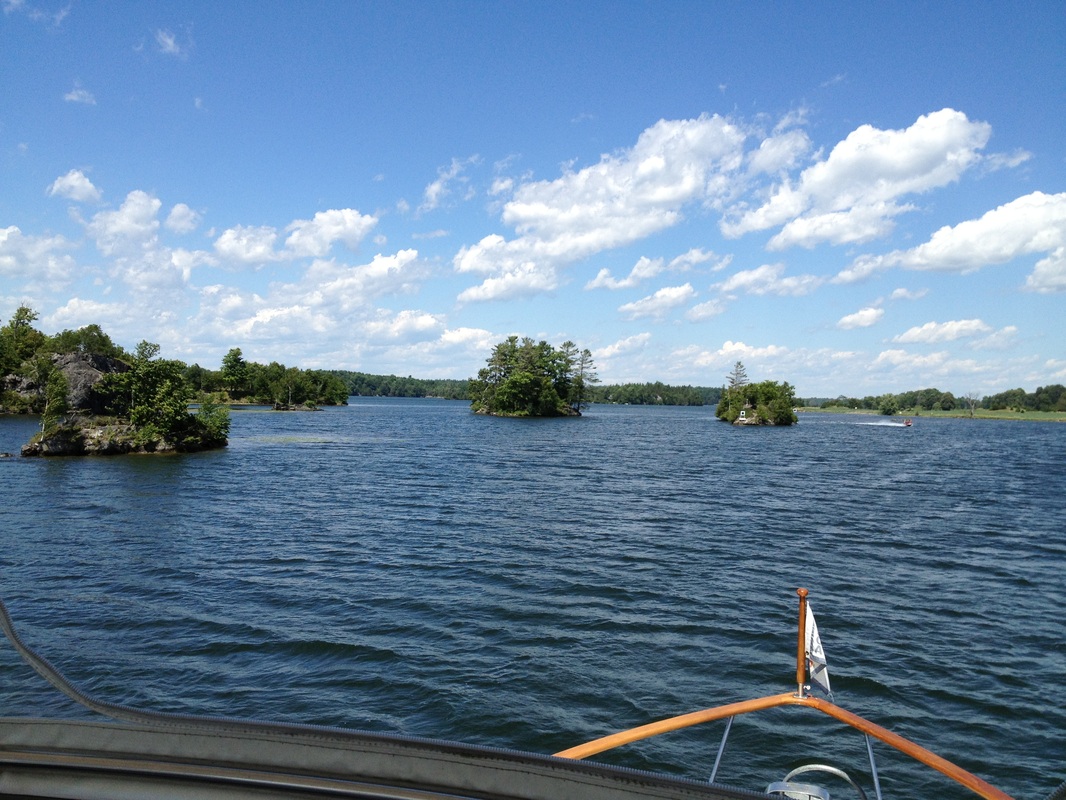 ....other parts of the Rideau Canal are large lakes dotted with picturesque islands. 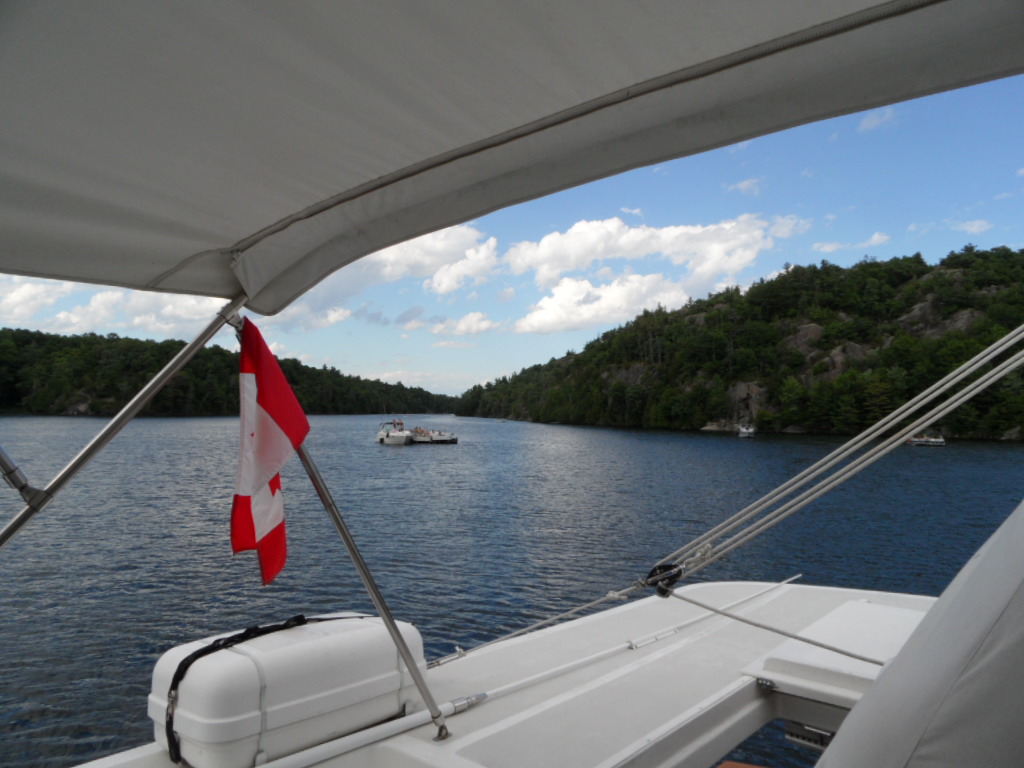 Our anchorange in Morton Bay - by dark there was only one other boat in the bay. Notice our Candian courtesy flag. It is customary to fly the flag of the country you are visiting.
Friday, June 29 – Day 56: Today was an off day for the Rickshaw crew in order to absorb as much as possible about Kingston, Ontario. As we soon discovered, Kingston is a very popular weekend getaway destination for both Canadians & Americans with a lot to see & do. According to one of our tour guides, it is the largest fresh water diving location in the world due to the large number of British ships that were scuttled in the neighboring waters during the 1800’s. It was the venue for the Montreal sailing events during the Olympics several years ago, because of the great sailing in the area. Being at the intersection of the Rideau Canal, the St. Lawrence Seaway, and Lake Ontario, it has a long history as a strategic military location as evidenced by a large number of forts and other battlements in the area. It was also the original capital of Canada and so has a lot of history and very old buildings, dating back to the early 1800’s.
Our day started with a bike trip to the local donut shop, Tim Horton’s, to get an internet connection fix via their free Wi-Fi to get updated on emails. Following the email update, we took a tour via a local hop-on / hop-off trolley of the town, which took us around the town and the surrounding area. One of the highlights of the tour was a visit to the fort that looks out over the harbor, and was built shortly
after the War of 1812 by the British to protect Kingston and the naval shipyard from attack by the enemy, the United States. Since this year is the bicentennial of the war, there were a lot of re-enactors throughout the fort, dressed in period uniforms and costumes, marching in rigid formation and even a cannon volley off of the fort wall overlooking Lake Ontario. Following the trolley tour, we jumped on a free (yea!) ferry over to the largest of the 1000 islands (which is an archipelago in the St. Lawrence), which was “Wolfe Island”, named after the famous British general, “James Wolfe”, that won the battle of Quebec during the French & Indian war. Please check out the poster shown below that we had seen at the Mariners’ Museum in Newport News last year.
We wrapped up the day by peddling over to the local hardware store & grocery store before returning to Rickshaw, where we met some great folks, Eric, who is originally from Toronto and has a beautiful 1987 41 Defever, and a couple of other loopers, Mike & Judy, from Virginia Beach, who were looping on their 50ft boat, One September.
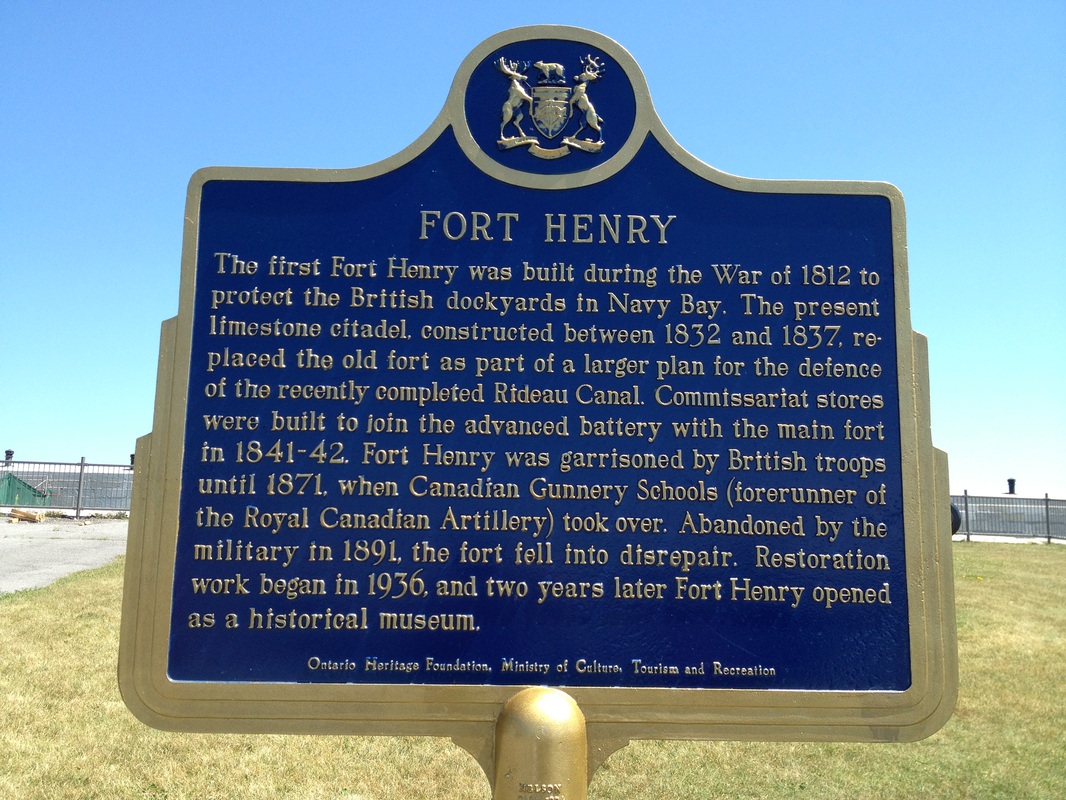 A little history about Fort Henry. 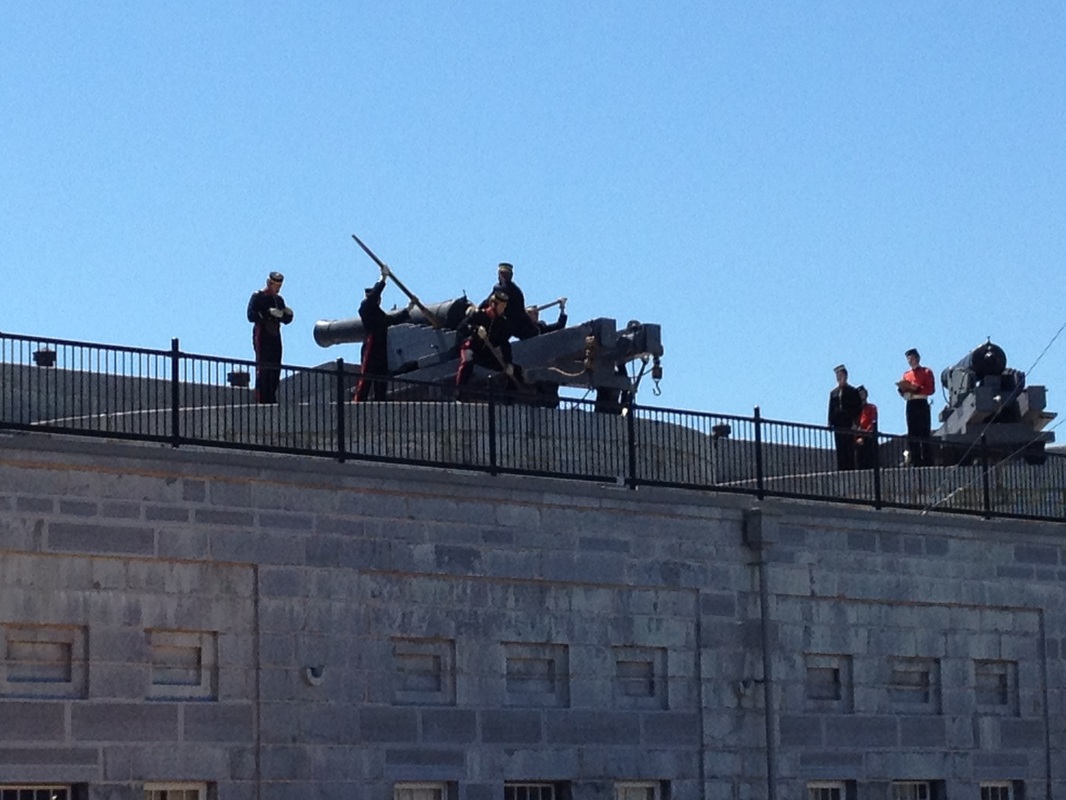 The cadets loading the cannon for the demonstration. 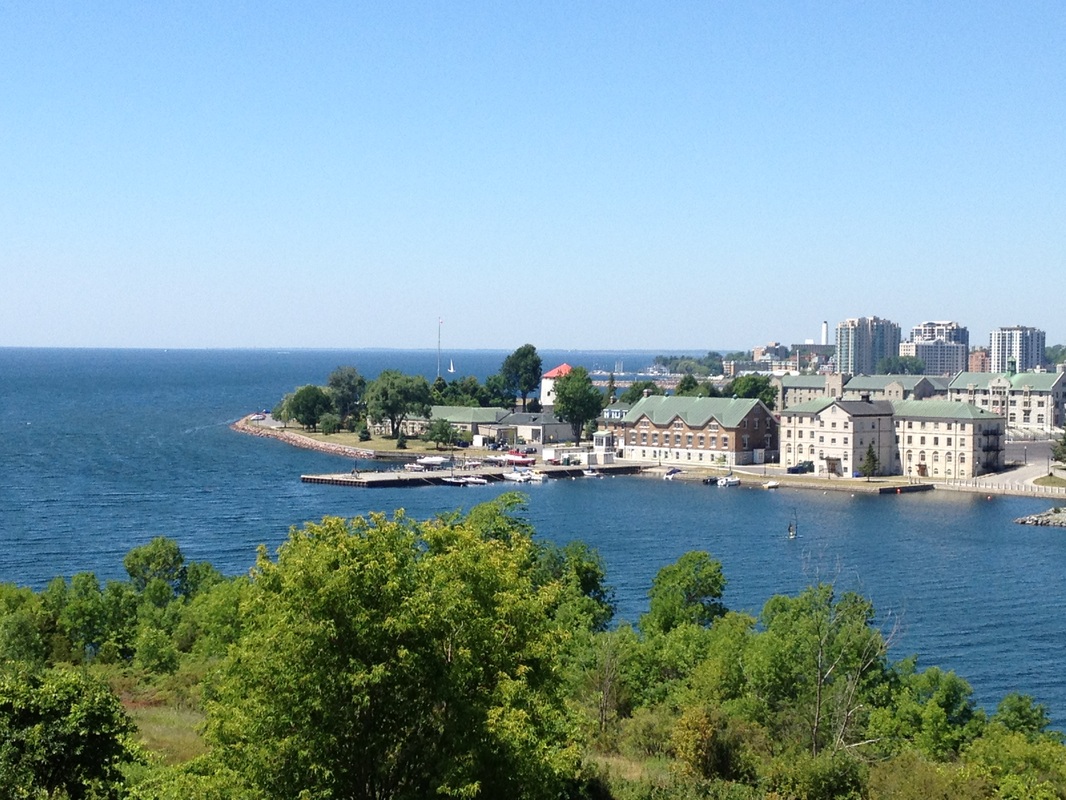 From the fort - the view of Lake Ontario in the background and Kingston Harbor in the foreground. 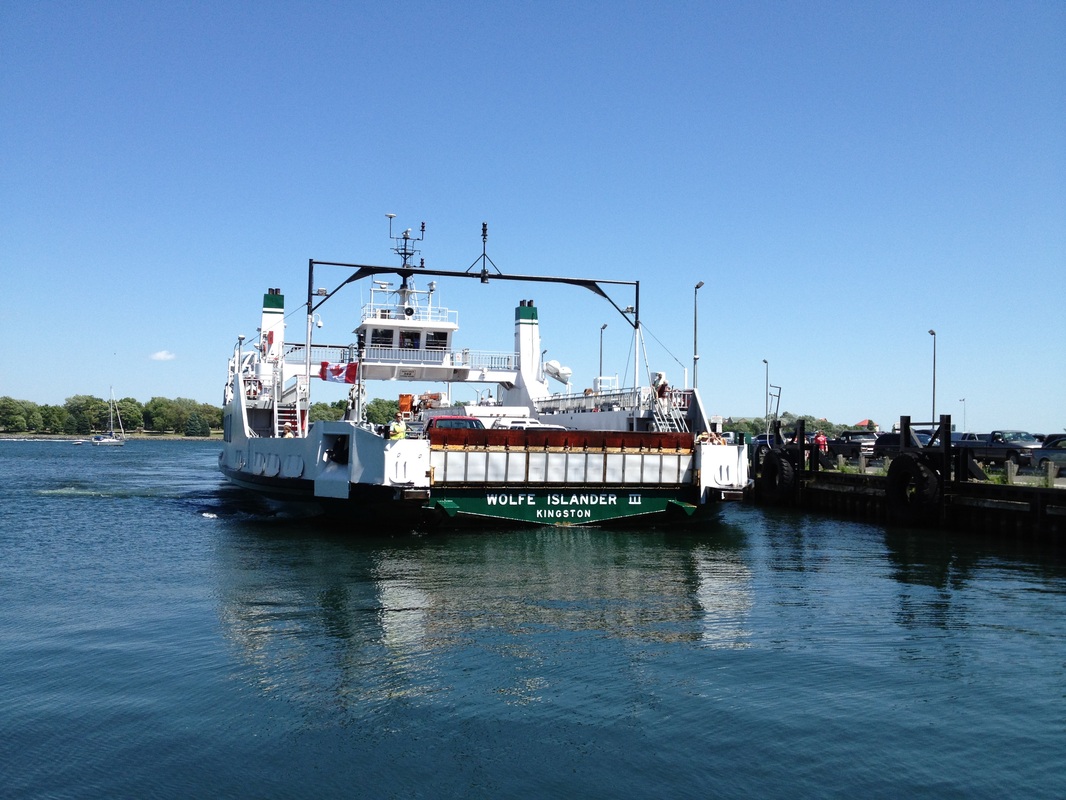 The ferry, Wolfe Islander, that took us to Wolfe Island. 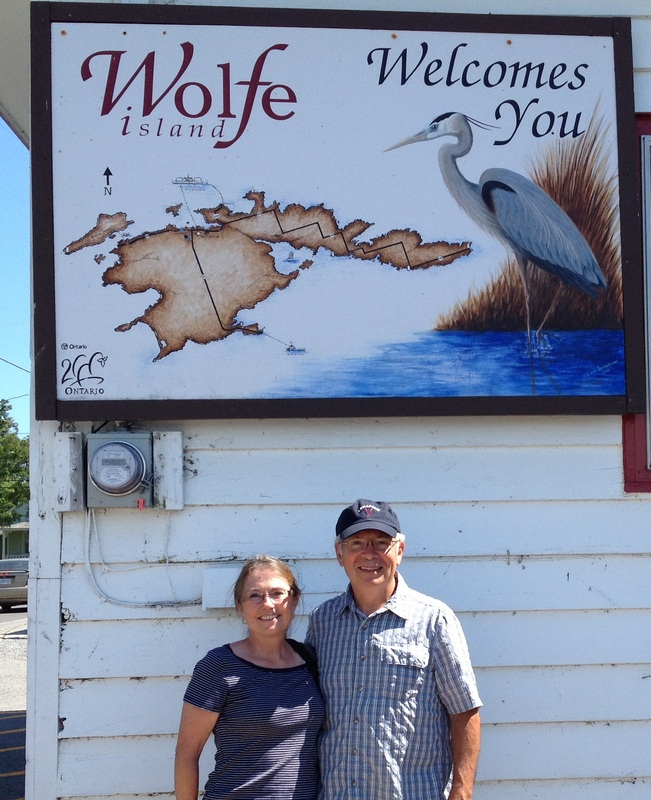 Jim and Belinda on Wolfe Island. | 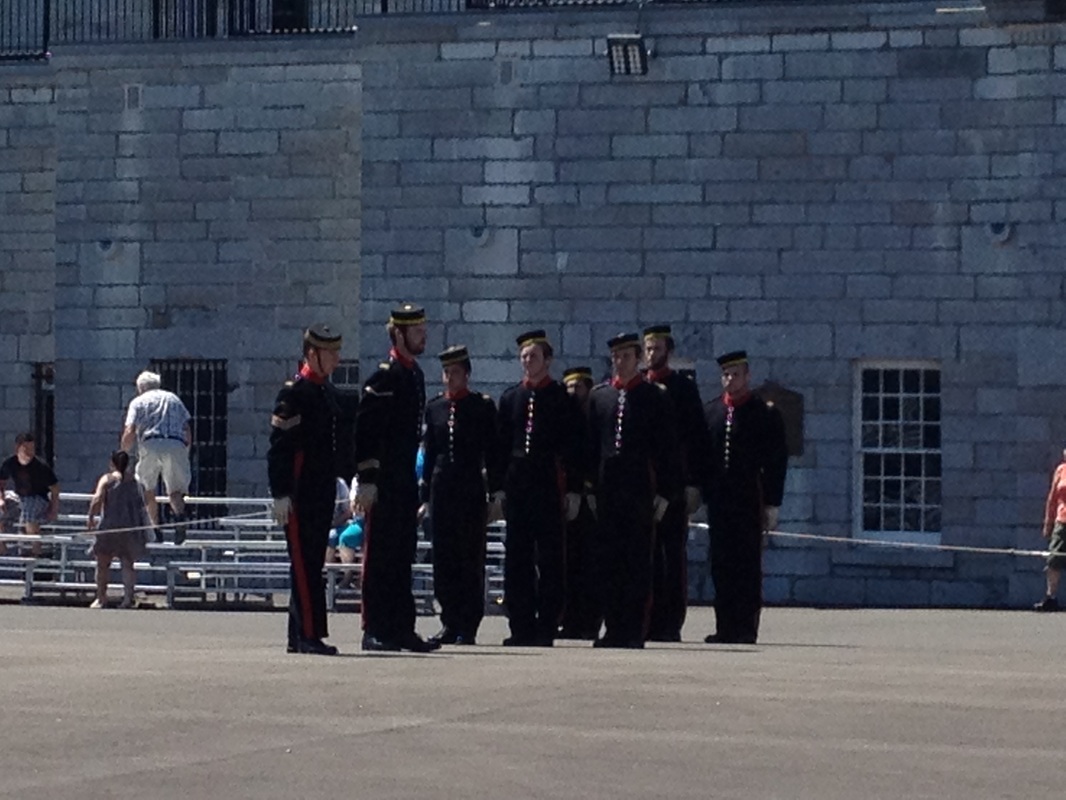 Fort Henry cadets passing inspection. 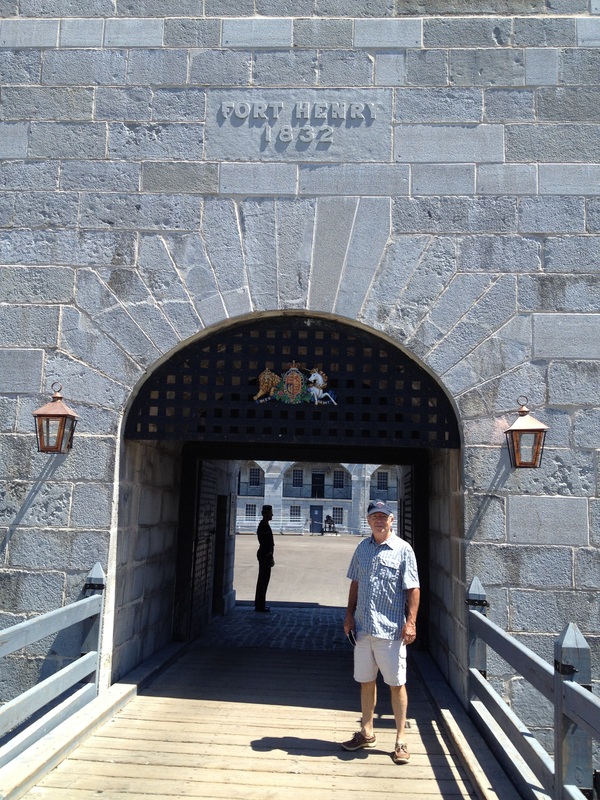 Jim crosing the dry moat bridge. This far north they can't have water in the moats. The water would freeze and the enemy could just walk across! 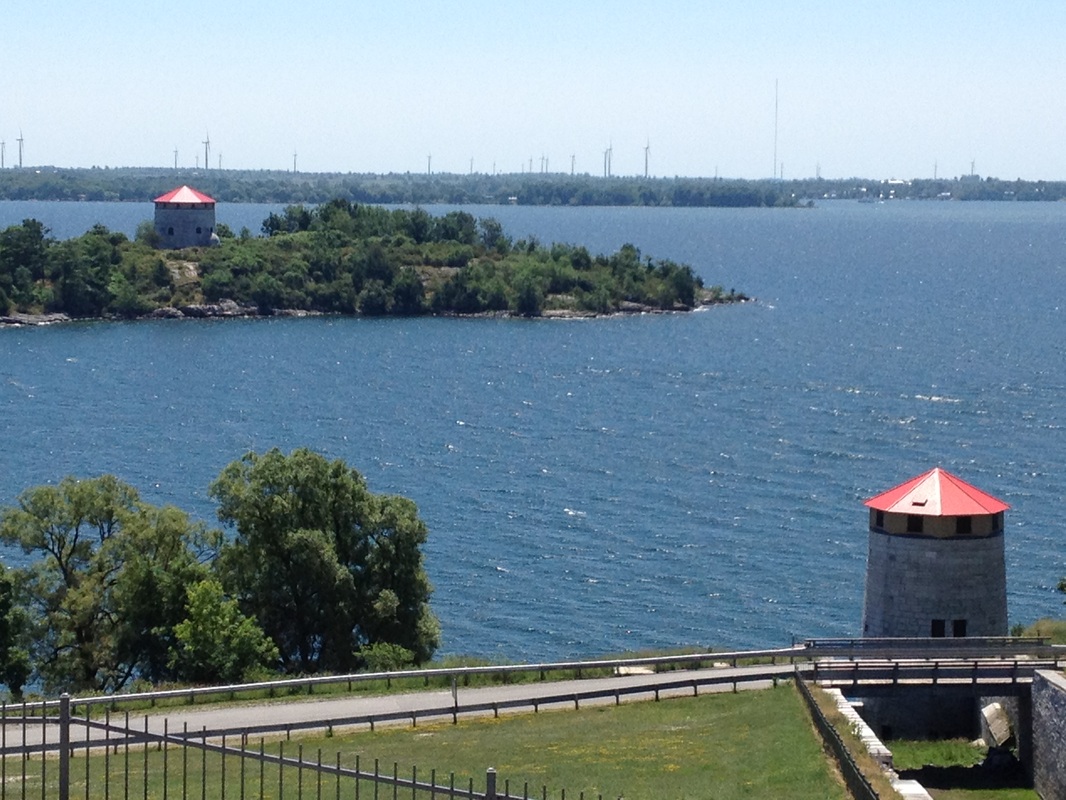 The round buildings are martellos. They are guard/gun towers to guard Canada against the United States. 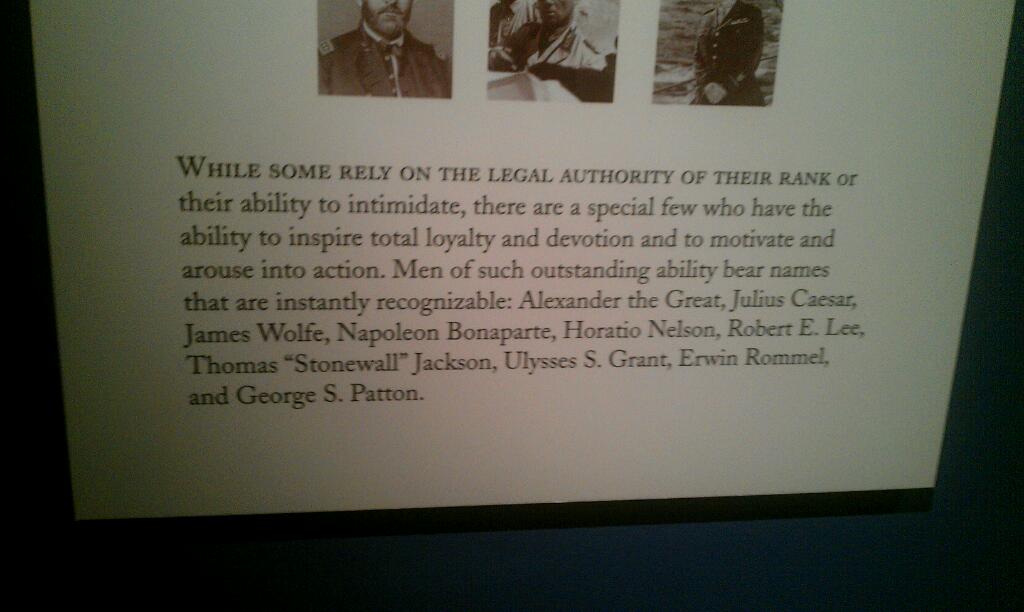 We saw this poster about General James Wolfe (at least we think that is the James Wolfe it is referring to) in the Newport News Maritime Museum. |
Thursday, June 28 - Day 55: Two boats moved into the lock for the first passage at 7am but Rickshaw wasn’t one of them. She was a bit slower, joining the second group of three that went thru about 7:30. Once out of the canal and out of the jetties we were in our first Great Lake – Lake Ontario. The weather was absolutely
beautiful! It was mid 60s when we left, the winds were light and the seas were 1 ft or less. The high in the afternoon reached in the mid 70s. We traveled 51 nautical miles today; all but 5 miles was in open water. It seemed we were the only
boat on the lake – we went hours without seeing another boat.
Once across the lake we turned east and followed the coast a short way, then turned north into Kingston Harbor. We were both very excited about finally arriving in Canada. But we had to learn patience first! Shortly after entering Kingston Harbor, we were within 200 yards of our marina but we had to wait 30 minutes for a lift bridge to open to allow us to enter the inner harbor. Then once through the bridge opening we called the marina for docking instructions. They told us they would get right back with us – 40 minutes later we were still circling the river waiting for further instructions. Finally we got docked then we called Canada Customs to check in. Before leaving the US, we had conferred with lots of other loopers who had already entered Canada and they all said it a breeze. No
questions about liquor, no questions about house plants and no boat inspections. And if they do ask about liquor, just be honest, they said, and tell them it’s for serving on board only, they really aren’t that strict. They only asked for some documentation information, made sure that you don’t have any firearms and your length of stay. So, boy were we surprised when they asked about how much liquor(40 oz per person is allowed duty free), any house plants, any fire arms, etc. We were completely honest and when we told them three boxes of wine (totaling over 300 ounces), 7 beers and misc. half empty liquor bottles and two house plants. To our amazement, they said “Well, we’ll have to send some officers over there right away – you will have to donate those plants to the Crown, i.e. throw them away and absolutely - DO NOT GET OFF YOUR BOAT”. Belinda was REALLY sweating it – one of her house plants was a get well gift to her mom when she was in the hospital in 1956! This plant has gone from Missouri to California to Tennessee to Texas back to Tennessee to Arizona to Georgia to North Carolina to Virginia and has been on Rickshaw since. Forty minutes later, here they come and they didn’t look happy. We thought they were going to get out our measuring cups and measure the ½ bottle of rum, the 2/3 bottle of vodka, etc.
Then they turned to us and asked “Where do you keep your firearm?” As if, “you’re from Tennessee, you must have guns!” Of course, we didn’t have any firearms – we know better than bring firearms or mace into Canada! They sent us outside, talked privately then came out and said they would have to tax us on the value of the wine on hand. The charge was $36. Then they said I was not to dump any of the dirt from my plants in Canada – NO PROBLEM. We were relieved to pay the $36. It was a convenience charge to be able to buy the wine we like while we had a car in the US and not trying to bike it back to Rickshaw. We are now free
to move about the country! Later we learned Kingston is the training center for all the new Customs agents - so they are ‘very conscientious’. Lucky us!
Once that business was taken care of we went out in search of internet service. Our plan was to buy a Rogers (the Canadian Verizon) wireless stick and a no contract wireless plan. We had researched them on the internet. No problem – IF you are a Canadian citizen with proof of residency. They will not sell post-paid wireless plans to non-residents and they don’t have pre-paid wireless plans. Rejected we left; resigning ourselves to finding hot spots - bummer. A few blocks later we stumbled on an electronics store (think Radio Shack) that sold cell phones. We thought we would ask them – the guy agreed with Rogers – he can’t sell post paid internet devices to us either and he also doesn’t offer pre-paid. Then his light bulb went off – he sold us a cheap prepaid smartphone that has pre-paid wireless with tethering capabilities. It ended up better than the wireless stick we expected to buy – we can make calls, use the GPS map app for getting around town, check the weather and connect up to 5 devices. What a find!
We had had a stressful afternoon so we found a nice sidewalk café just across from City Hall on the waterfront and enjoyed a nice dinner listening to the country
band playing a free concert in the waterfront park down the street.
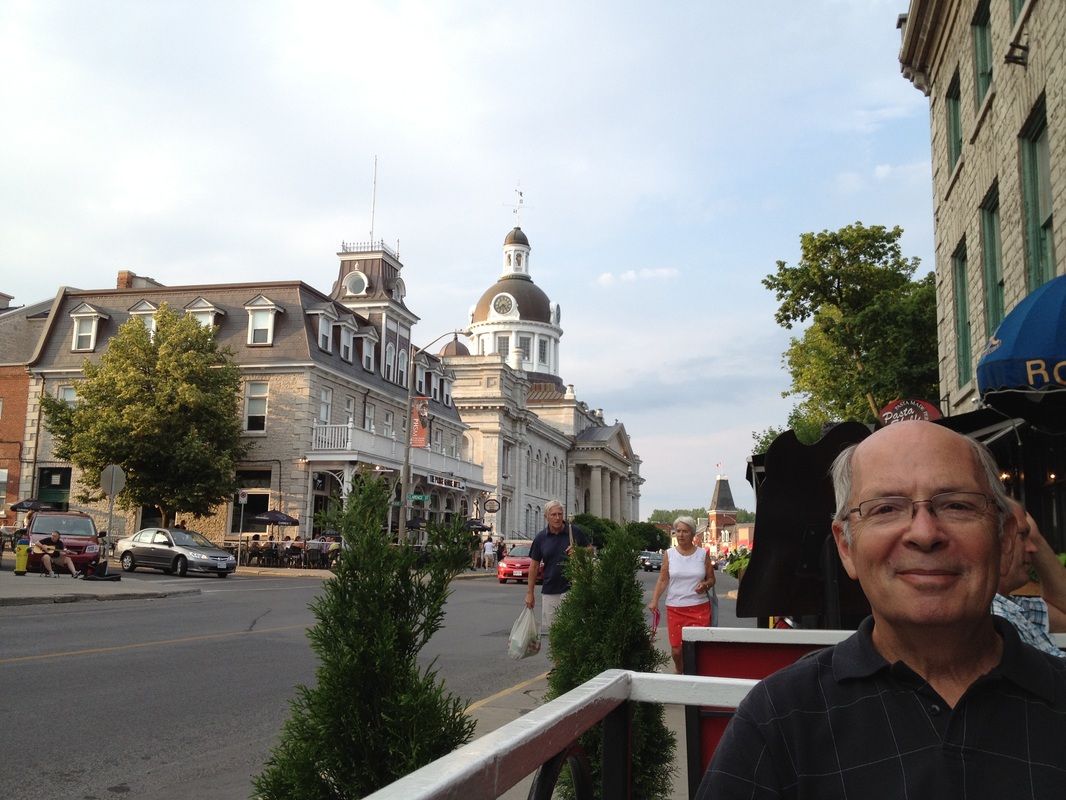 Jim at the sidewalk cafe in Kingston. City Hall is in the background. And not seen but heard is a country western band under the trees behind him.
June 25, 26 & 27, Days 52-54: We have been in Oswego, New York since Sunday afternoon. Mostly we have just been killing time waiting for favorable weather to cross Lake Ontario. We have made two trips to the hardware store, two trips to the grocery store, and the laundromat. We have worked on our on going project of refinishing the toe rails and just doing everyday house keeping chores. Jim got at haircut (check out the picture). This evening we hosted a pot-luck happy hour with four other boats. The winds have been blowing 20 mph with 4 ft seas everyday but tomorrow's (Thursday's) forecast is 5 knot winds and 1 ft seas. So, Thursday we are headed to Canada!!
Our internet service will be minimal while we are in Canada so our posting will not be as frequent. We will post when we can. 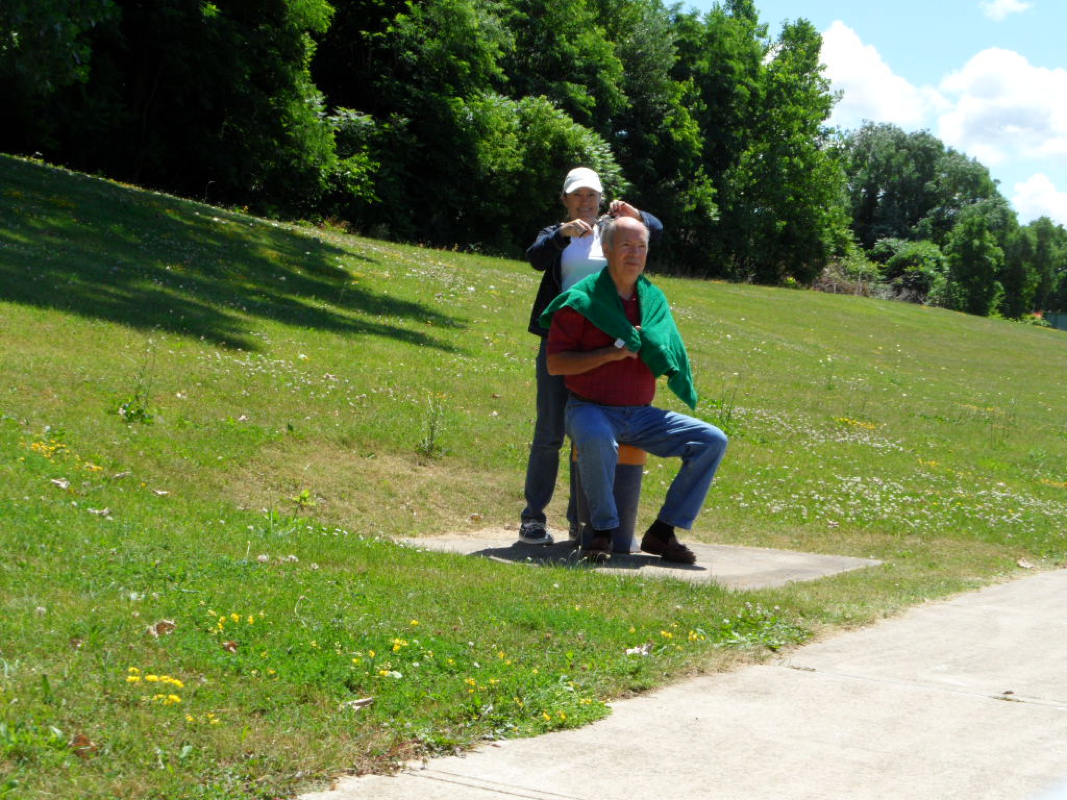 Belinda cutting Jim's hair. He is sitting on a bollard. 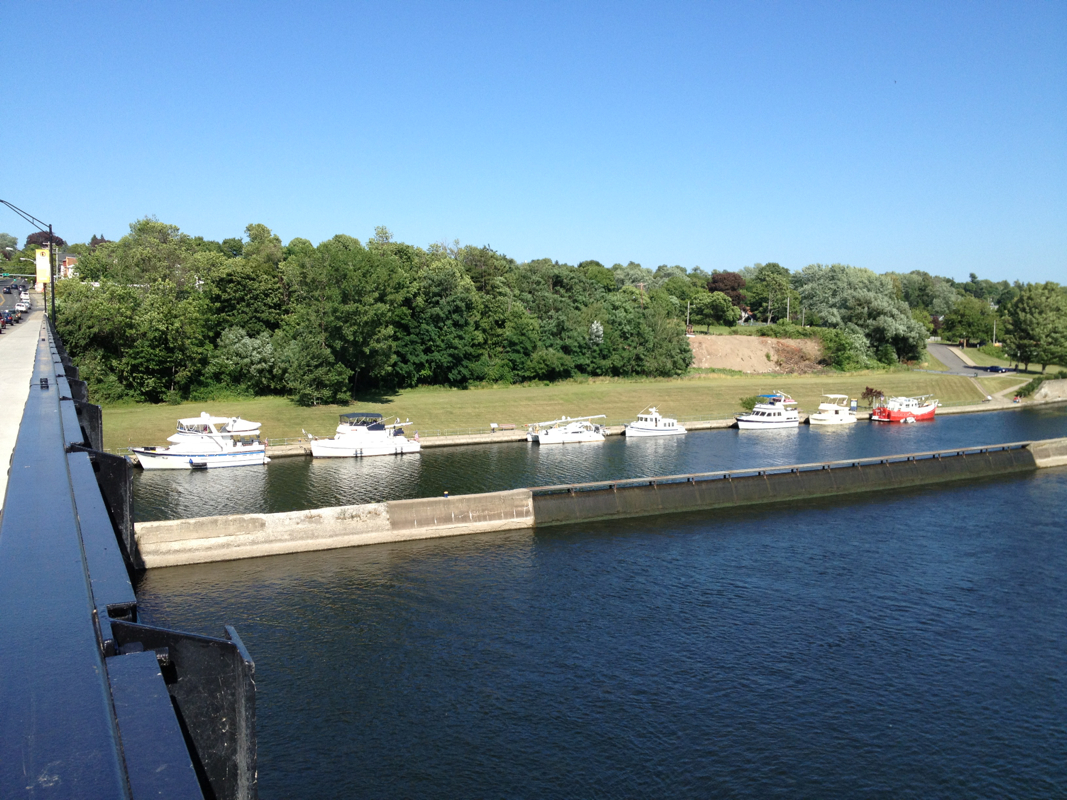 When we got to Oswego on Sunday we were the only boat here but the boats are stacking up waiting on Thursday good weather. Rickshaw is the first boat in the line
Sunday, June 24, Day 51: Today is our final day on the New York canal system, with our destination being Oswego, NY on the southern shore of Lake Ontario. Our goal is to position ourselves on the shore of Lake Ontario, and be ready for a break in the weather predicted for the next several days, which is forecasted to be 15-25 knots of wind out of the northwest or west. We need to cross the lake only if the wind is very light, because the lake has the reputation for being very nasty if the winds exceed 15 knots and from the west due to the long fetch across the river from the western shore. We went through another 7 locks today, all down & very easy, which was fortunate because a steady drizzle started about 3, leaving Belinda out in the rain during the locking process to handle the lines.
;
Once we cross the great lake, we will arrive in Kingston, Ontario, where we will clear Canadian customs, and begin our visit of Canada. From Kingston, we have considered several alternate routes: we can either go down (northeast) the St. Lawrence Seaway, towards Montreal, or we can go up the Rideau Canal toward Ottawa, or start our trip through the Trent-Severn canal system. After discussing the options with other experienced loopers, we have decided to go up the Rideau Canal toward Ottawa, which is renowned for its beauty and charm, reminiscent of canals in central Europe. 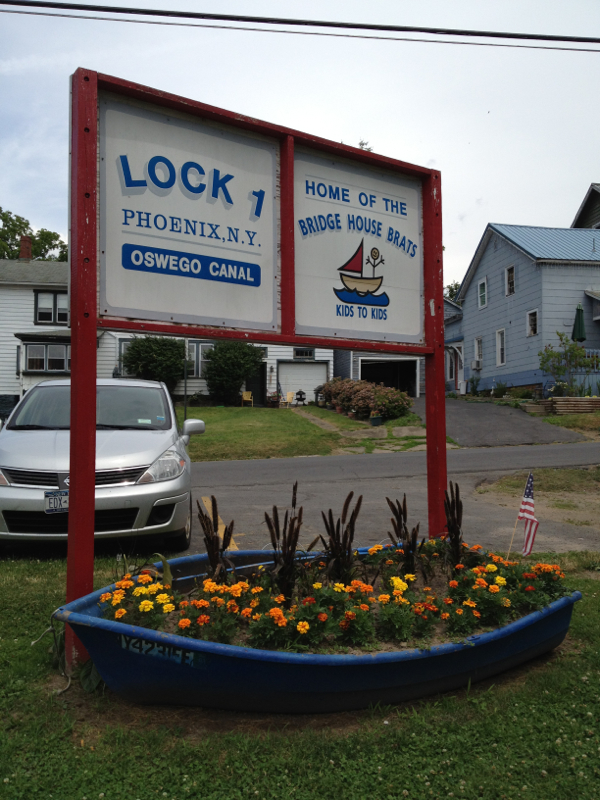 First lock on the Oswego Canal. We stopped for lunch here. 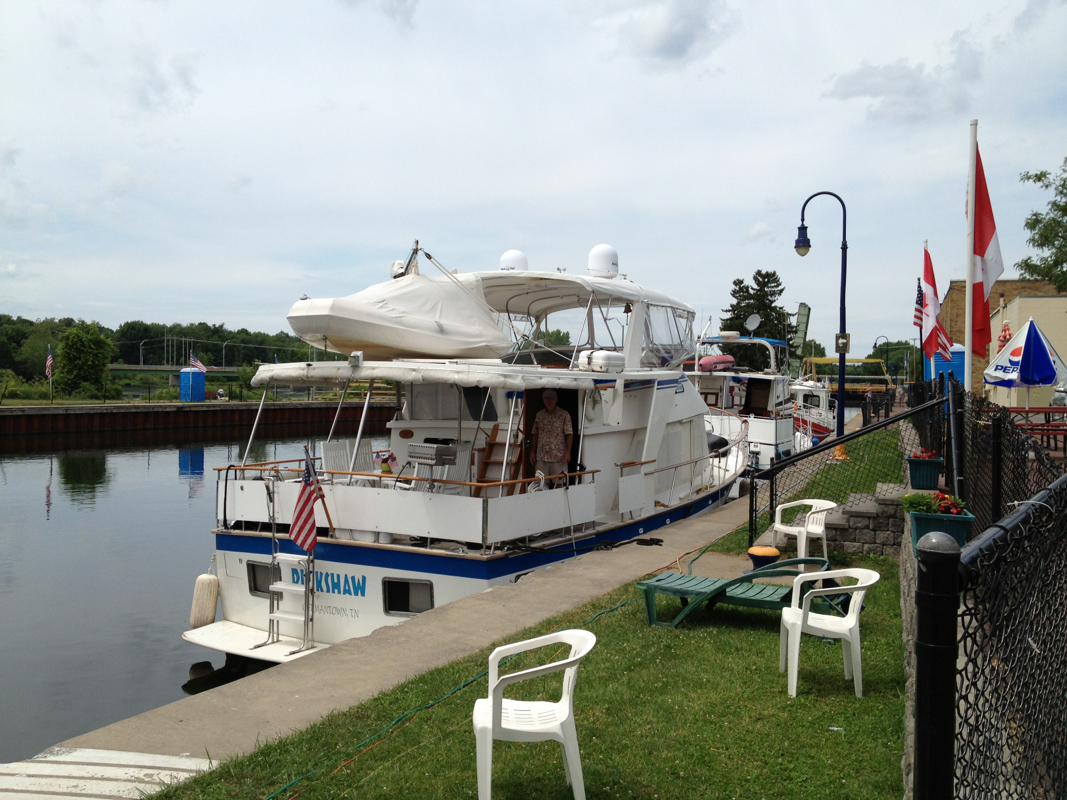 Our lunch spot.  Looking back in a lock after just being lowered. You can see the water line on the lock walls. Behind the gates is a wall of water. 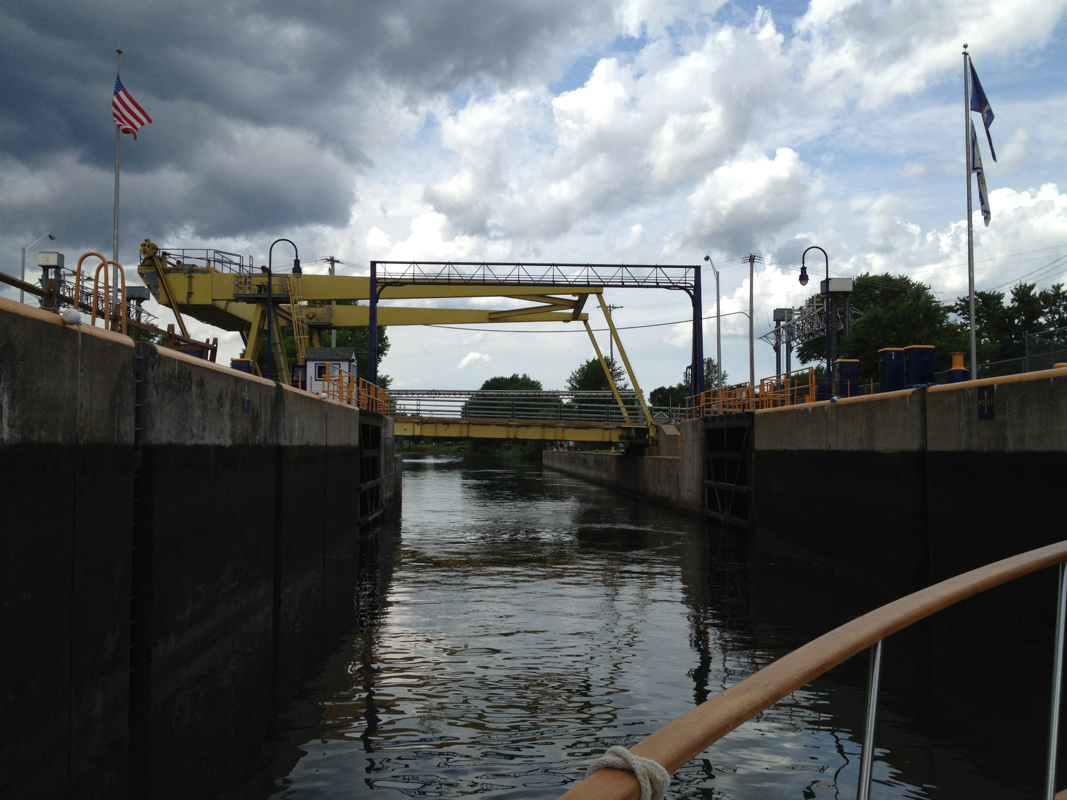 Surprise!! After the lock gates opened there was a bridge too low for Rickshaw to get under. We had to wait for the Lockmaster to raise the bridge. 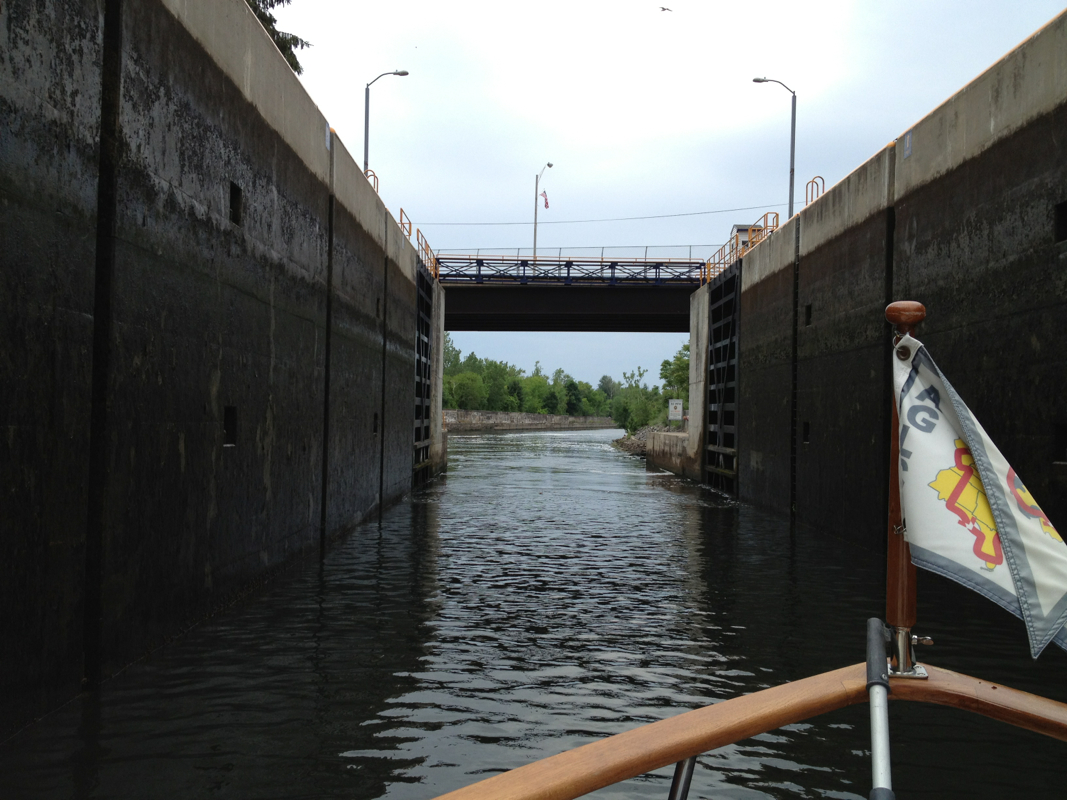 The gates of this lock just opened and we are heading out - 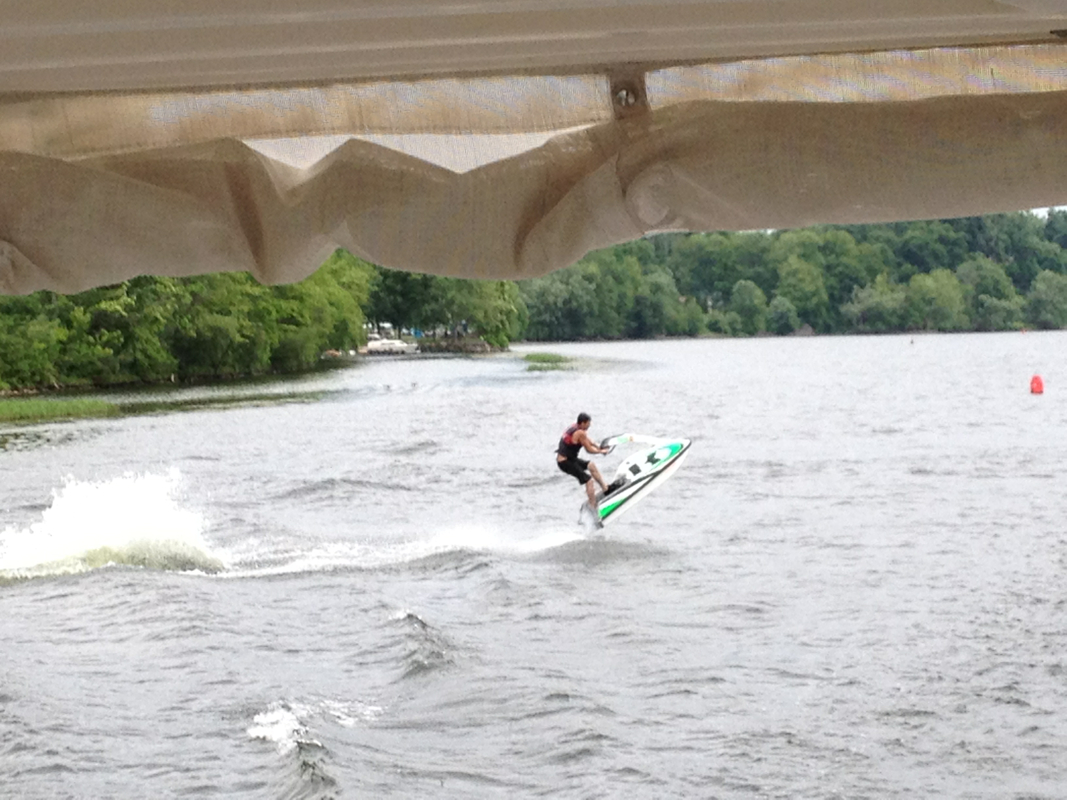 This jet skier is jumping our wake. He followed us quite a ways and put on a show for us.
Saturday, June 23, Day 50: Under partly cloudy skies, and with a fairly strong westerly wind, we departed Sylvan Beach and headed across the 20 mile wide Oneida Lake toward our next destination, Brewerton. Brewerton is a popular town for loopers because it has a number of marine facilities for making last-minute boat repairs and reprovisioning before exiting the US and entering Canada at the north side of Lake Ontario. At Brewerton, we parked Rickshaw at Winter Harbor marina, which is so named because it has a huge heated warehouse for storing boats over the winter. Since we had not bought fuel since the Chesapeake, we topped off our 3 diesel tanks with 500 gallons of fuel, and filled up our water tanks. 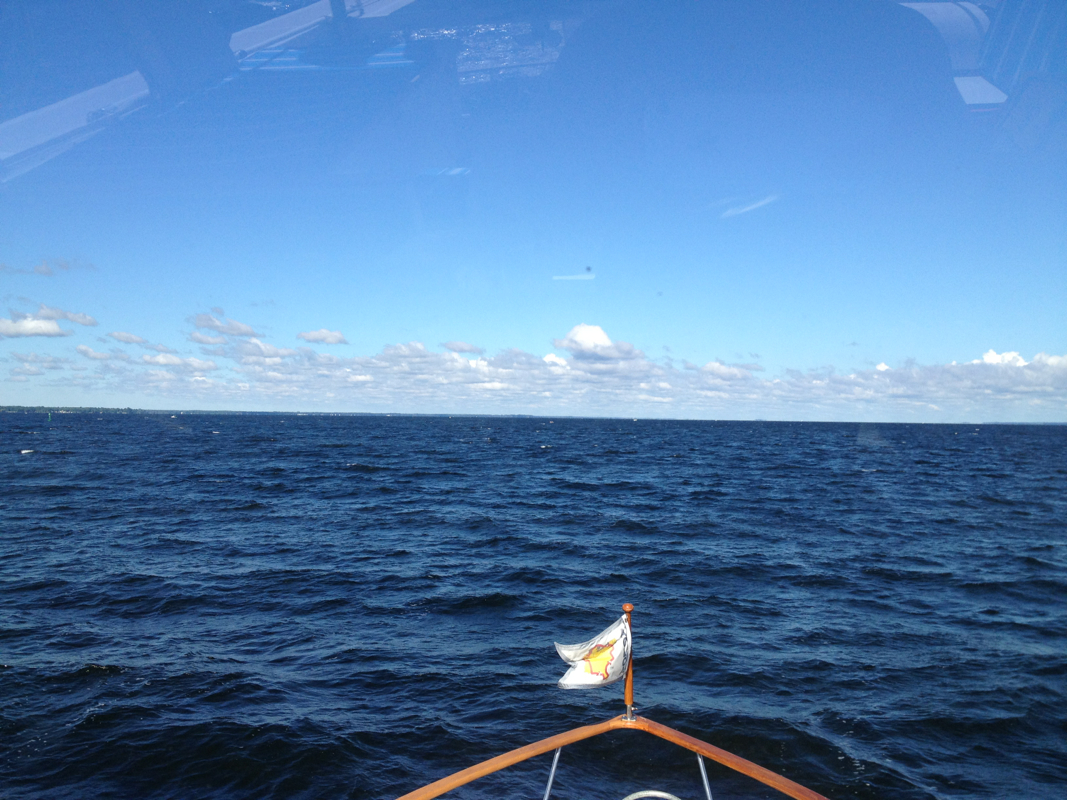 Lake Oneida is a very pretty recreational lake with lots of fishing boats and a few water skiers. It took a little over 3 hours to cross. 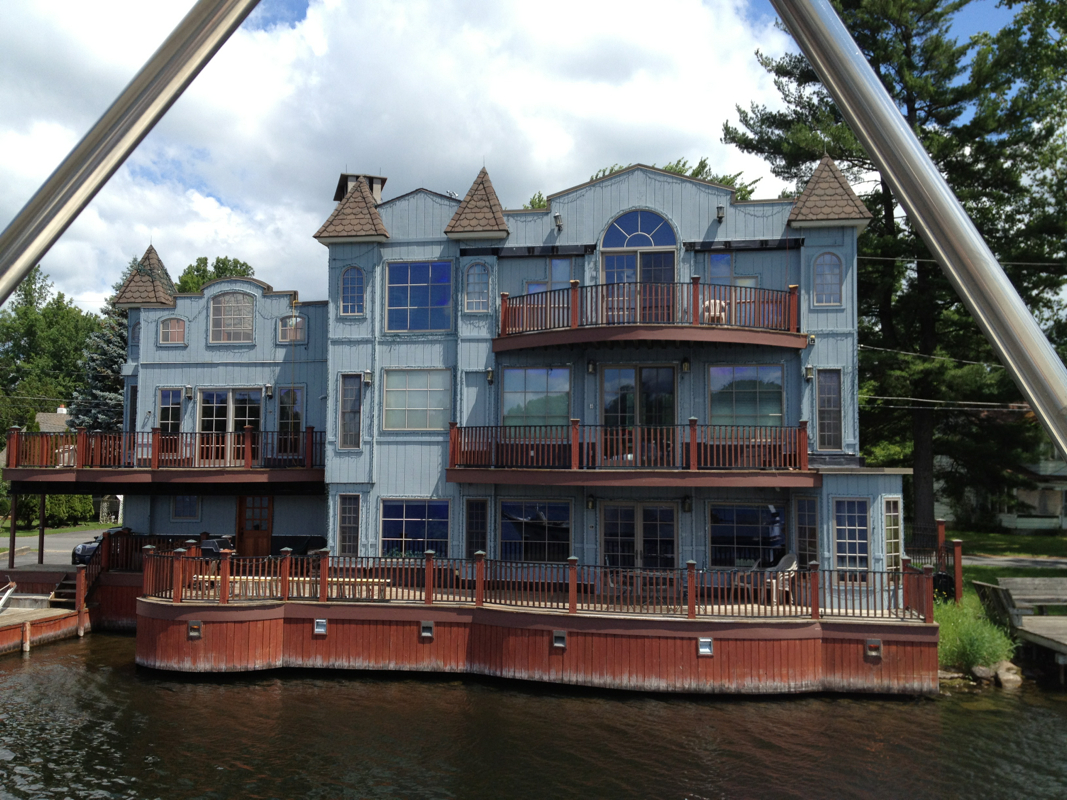 One of the homes along the bank of the Erie Canal. There were lots of rental cottages with docks also. 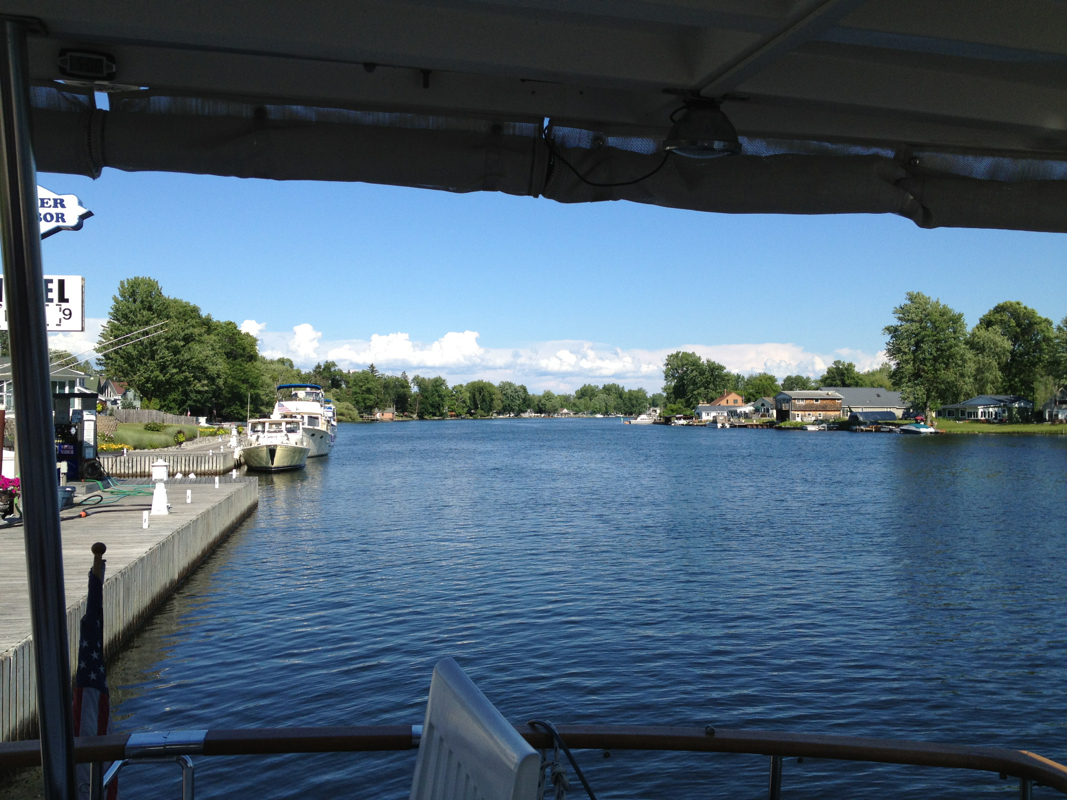 This was our view off the back deck along the Winter Harbor dock. The second boat back, with the blue top, is Wild Goose - DeFever owners Jim & Ann O'Malley. We had met them in Florida at a DeFever Rendevzous.
Friday, June 22, Day 49: After sleeping 10 hours we rolled out of bed at 8:30 to discover we were the only boat on the dock! We desperately needed the rest. Rickshaw pulled away from the dock a little before 10am. We did four more locks today - the first two raised us up but the last two locks dropped us down. This was the first time we locked down. Locking down seems somewhat easier - the currents don't seem as strong with the water draining out of the lock and the process seems to go faster when the lock is draining. We docked for the evening at a free city dock at Sylvan Beach which is at the eastern end of the local recreation lake, Oneida Lake. We were greeted by two Loopers (from different boats) who caught our lines and then later we met two more Looper boats. One was Bill and Laura on Kindred Sprits whom we had talked with on the VHF when we were headed to Atlantic City. Sylvan Beach was a very cute little tourist town, with a retro 1950’s feel, complete with hamburger shacks, ice cream parlors, and a small amusement park on the waterfront. This part of New York can have a very severe winter, worse than Buffalo, due to the lake effect of Lake Ontario, so the locals really try to get out on the water and enjoy the brief summer weather while they can. 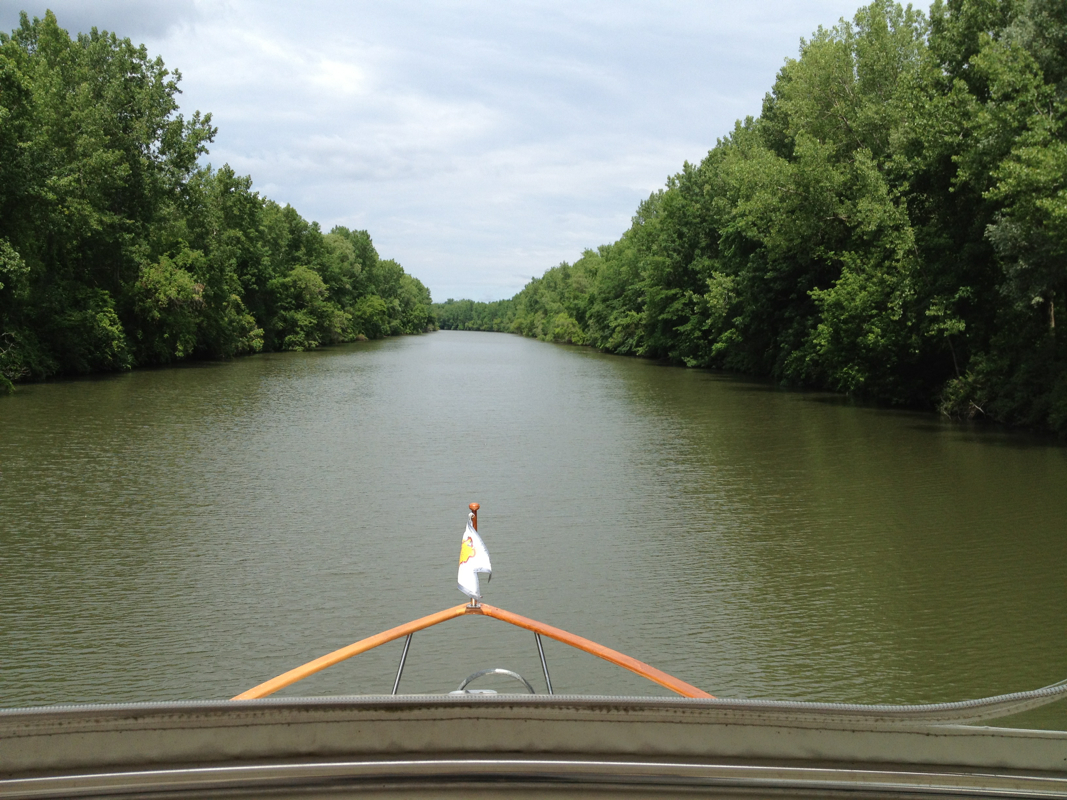 Heading west on the Erie Canal. Not what I had expected - it's very overgrown and uninhabited for miles. 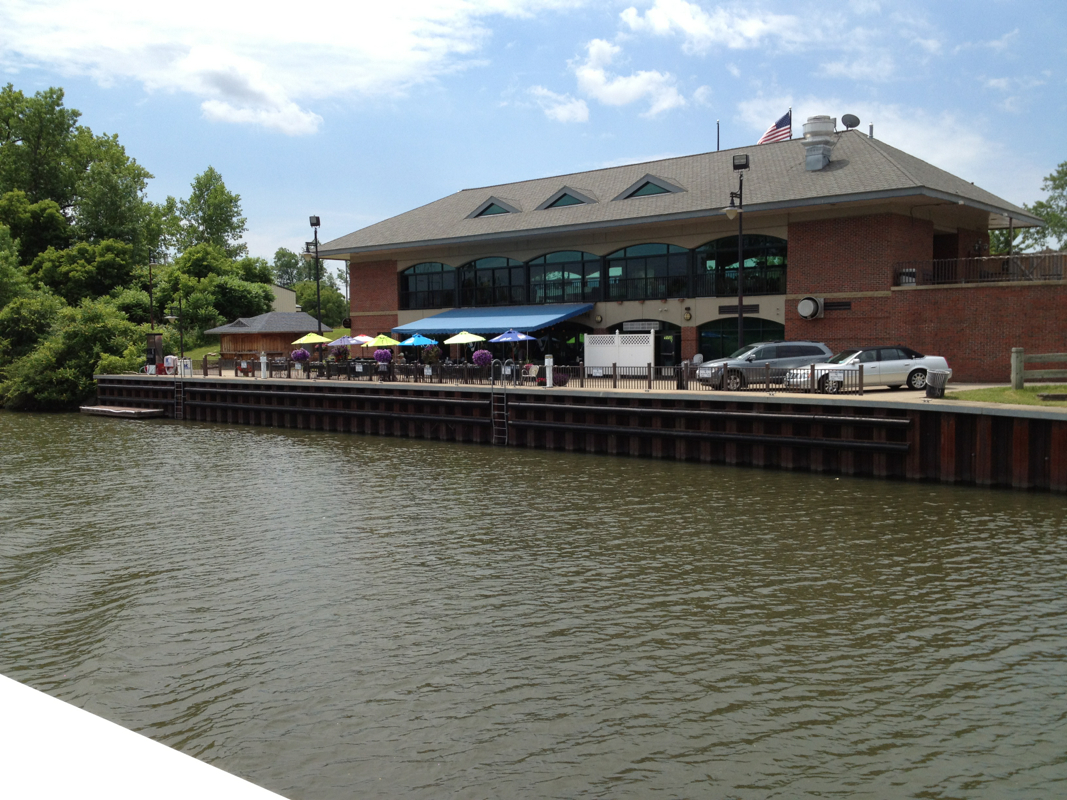 We came around a bend and saw this restaurant with dock. 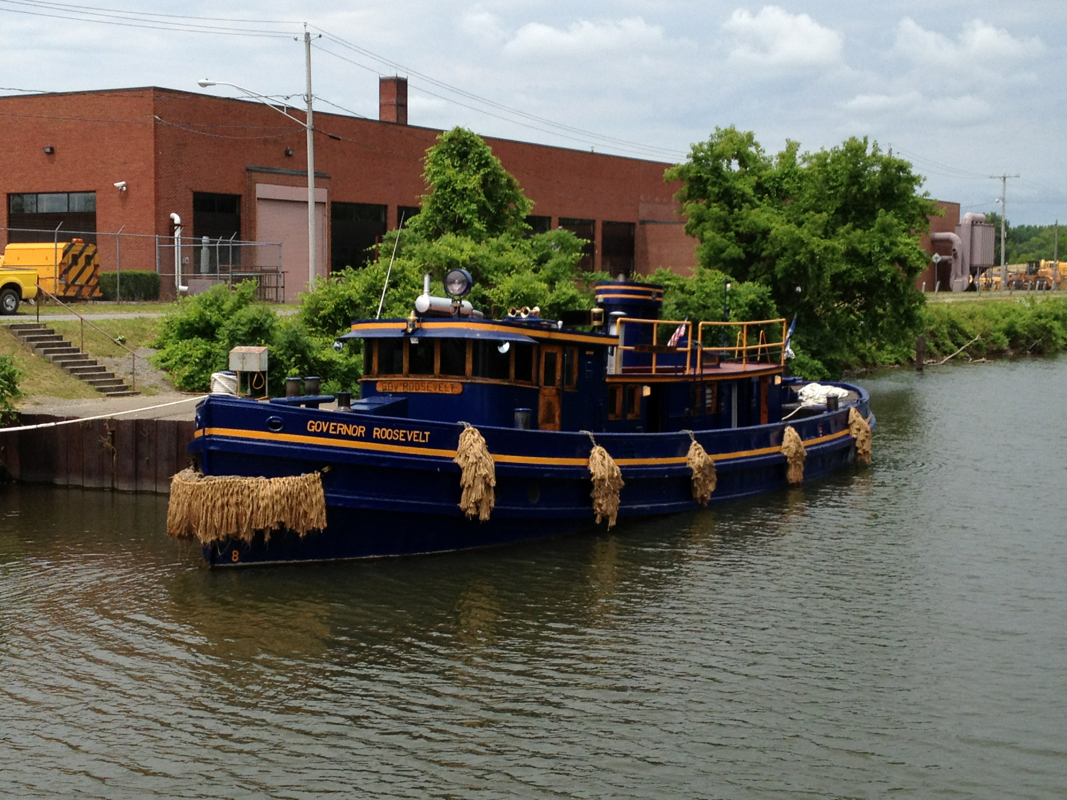 Another unusual boat. The fenders are unbraided lines. They look like big mop heads.
|









































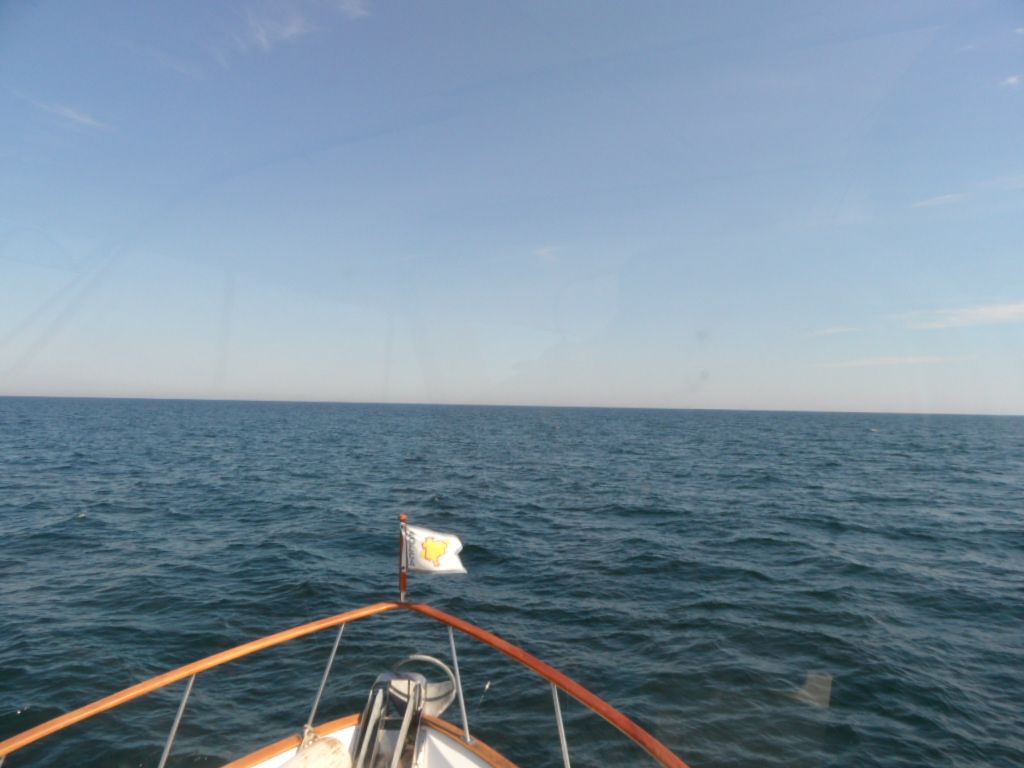















 RSS Feed
RSS Feed